Mecha by GimmickMan
It's just like one of my japanese animes!
Original SA post
Mecha: It's just like one of my japanese animes!
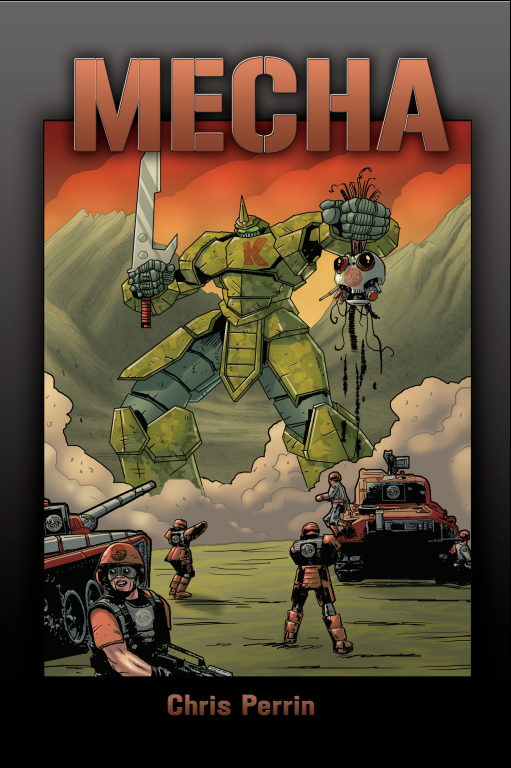
So, Mecha. I don't think I need to explain what the game is about, thus instead of trying to sell you in on giant robots I'll give you the quick and dirty look of the system before we go into the in-depth review proper.
Mecha, a game whose author claims is " Mecha done right ", is a generic system that disregards traditional math-heavy Mecha Game Design philosophy. If you've been paying attention to this thread or have done some research on games of this kind, this should come as a breath of fresh air. And for the most part, it is. You will not find tables of randomly determined hit locations, fuel weight calculations, and other old school design elements.
It has, however, a few quirks of its own. In prioritizing simplicity it may end up lacking in crunch and depth of gameplay, it also features classic indie game mechanics with a storygame bent to them, which don't work for everyone. It does them well though, or at least I thought so last time I read through it.
One slight problem is the organization of the book. There's no index, bookmarks nor obvious chapters signaling where things go so you'll spend a bit trying to find things if you don't have the benefit of the Search function. The semi-informal tone of the book does not help there, either. There's also some art of varying quality, which is somewhat sparse and repetitive but better than nothing. I'll showcase it when relevant.
Onward to the first "Chapter"...
The Introduction
We get the traditional spiel about roleplaying games here, plus some extra words trying to define what the hell a Mecha is.
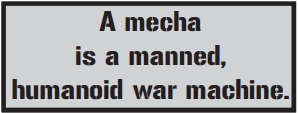
Well that was quick. Anyway, the game uses d6s. Lots of d6s "(eight per player should be about right)". We have a traditional GM role in this game, and this is one of those "The GM is female and the Players are male" types of books, which I guess is better than just using "he" all the time. Lastly, we are introduced to a "Tutorial NPC" that will help explain things to us as they come up in the book.
Mecha posted:
Also, included in this book is a guide, so look out for her. Her name’s Mara, that’s Lieutenant Mara Callahan to you, and she’s been a pilot with the 91 st Separatist Guard since the war broke out. She held Brightan Pass against an ADF counterattack when everyone else was running for the hills. At the battle of Grave Canyon, her team made it out alive when half the other Separatist Guard units were blowing up around here. Command trusts her to take on the missions that can’t fail. So listen up when she talks and you might just stay alive She also knows she’s in a game, so she can talk frank about the rules of the game
See I really like the idea of using example characters to guide you through the book like this game and Bliss Stage do (The Dresden Files RPG did it fantastically) but here she doesn't even get to say anything. Instead we're given a ton of information that a) makes no sense to us and b) we don't really care about. It is a really minor nitpick though.
By the way, I said Mecha is a generic system, but it includes a bunch of prewritten settings (Setting Reference Schematics... or 'SRS', get it?) if you're too lazy to make your own. Mara here is from the one that seems to be the most developed of the bunch, it is the same setting that their free Quickstart rules are set on, too.
And that's all for the introduction, but don't worry, we'll get to the juicy bits soon enough...
Coming up Next: Character and Mecha Creation!
Man & Machine Are One
Original SA post
Mecha: Man and Machine are One
Character and Mecha creation are one singular, intertwined process in this game. And in fact all machines are tied to their owners, the reasoning for this is that the mecha is usually a reflection of its pilot in anime. It is pretty cool approach, if you ask me.
Here's the outline.
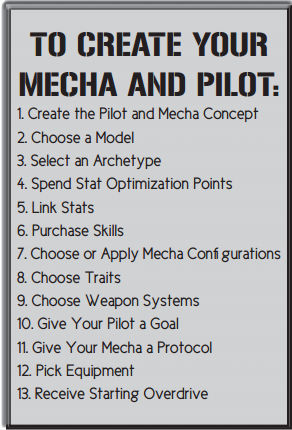
I'll be doing this all at once, because it takes all of 10 pages. The way the book is organized, reading through the steps is fast... its just that most of the actual options we'll be choosing are detailed elsewhere.
1) The Concept is easy enough, we're given a bunch of genre staples as examples like the hotheaded jock, the remorseful veteran, etc. This is not a mechanical thing but rather a guideline, I am sure you've seen it in other games. We get a few characterization questions like "Why do you fight?" and "How do you feel about your fellow teammates?" to go along with it. There's also a mention that each SRS in the book has a list of recommended concepts, which is a nice touch.
2) Choosing a Model involves heading into the section of each individual SRS and selecting a template from the ones available. A Model will give you your robot's base Stats, which are:
Mecha posted:
• Weapons - The number of weapons systems the mecha starts with. This stat is always used to determine the Attack linked stat.
• Armor - A measure of the mecha’s resistance to damage. This stat is always used to determine the Defense linked stat.
• Technology - A measure of the sturdiness and efficiency of the mecha’s internal systems. This stat is always paired with another stat to determine Engineering.
• Speed - How fast the mecha moves. This stat is always paired with another stat to determine the Movement linked stat.
We get our first mention of paired, or Linked, stats here. We'll get to those in a minute. For now, we should know that each of these stats goes from 1 to 6.
3) Next is to choose our pilot's Archetype, this one is SRS dependent too, and is basically the same thing. Here are pilot archetype stats.
Mecha posted:
• Strength - How physically strong the character is and how well he can resist damage.
• Agility - How graceful and dexterous the character is. This stat is used most often in combat outside of a mecha.
• Intelligence - How fast the character’s mind works. This is used for book smarts.
• Will - The character’s determination and social acumen.
You can probably see where this is going. Again, they go from 1 to 6.
4) Is to customize them both! Each Model and Archetype have a few points to spend to power them up in a 1 by 1 basis. Model points can only be spent to buff up the mecha, and Archetype points can only be spent on the pilot, for obvious reasons.
5) Things get fun about now, we now are to Link each stat from the mecha with another of our choice from the pilot to derive a few substats. These substats are our dicepool for most of our actions when out in the field punching other robots in the face. We have yet to see the core mechanic, though

Mecha posted:
• Attack - The mecha’s offensive strength.
• Defense - The mecha’s defensive strength.
• Engineering - The mecha’s initiative
• Movement - The mecha’s speed
What this means is that our fighting prowess can come from whether we're actually using motion feedback through Strength + Weapons, traditional reflex-based piloting via Agility + Weapons, or whatever else we can come up with. The justification is entirely up to you. This mechanic is downright brilliant and if you don't see how awesome it is then this game might not be for you. It is important to note that while linked stats can go from 2 to 12, they cannot start over 8, so don't be a munchkin and spread them out a bit.
Mara posted:
There is one important thing to note. The decision of which basic character stat links to which mecha stat is made at character generation and is the same for every mecha he pilots. Once play starts, the link array cannot change and they are the same for all mecha he might jump into.
Also, the mecha cannot take advantage of linking if it has been destroyed.
The question is always asked “Can I link my stats however I want?” Yes. You can choose any character stat to link to any mecha stat as long as you only link each of your pilot’s stats once. So with one character, you may link Will to Speed. With your next character, you might link Strength to Speed.
Mechanically, this means is that you add the two stats together to figure out how many dice to roll. When role playing, you should describe your actions based on how you link
6) Purchasing skills. Here's the entire list.
Mecha posted:
Mecha Combat – How well the character can fight in a mecha. This covers both movement and making attacks.
Personal Combat – How well the character can fight outside a mecha. This covers the pilot’s movement and attacks outside of his mecha.
Social – The character’s ability to interact with others in order to charm, persuade, or anger them.
Field Ops – A skill which governs a range of skills from espionage, recon, stealth, breaking and entering and theft. It can confer a tactical advantage in combat.
Repair – A character’s ability to repair damaged mecha
Medic – A character’s ability to heal wounded pilots.
A far cry from Call of Cthulhu, eh? PCs always have at least 1 point in all of them, and the Archetype gives them a few bonus points in each skill, as well as some to be spent as you choose. Skills may not go higher than 5, and there is a cap of 3 for chargen.
7) Configurations, which are a pilot's quirks that improve what the mecha can do. They are SRS dependent (seeing a pattern yet? hope you like flipping back and forth) and are tied to specific Models as well. We get to choose two Configurations from those available to our Model, and they give your robot a fancy power to use, as well as a choice of two personality Traits. So that's two abilities for our robot and two Traits for the pilot. I'll leave it to Mara to give an example.
Mara posted:
For instance, a player chooses the Assassin and Disrupter Configuration for her mecha. She must now choose whether her character is Stealthy or Brutal because of Assassin and whether her character is Static or Dynamic because of Disrupter.
To complete this step, check your mecha model. If it specifies one or both of the mecha’s Configurations write them down and then consult the following table to pick one of the two Traits associated with that Configuration.
If the model does not specify, then use the following table to select two Configurations for your mecha and then select one of the two Traits associated with each Configuration.
I'll go into the specific Configurations in more detail when I get to making example characters.
8) Let's look at what these Traits we just got actually do, since we now have to get two more of them for a total of 4. Traits give you Advancement Points for good roleplaying, one for each Trait that you incorporate into your make believe each session. Your Archetype determines which other two Traits you can grab, by the way.
As an aside: I don't know why they thought tying down how you should roleplay to what you can do in combat is a good idea, but at least it is an easy enough thing to fix. Same for the XP method. They both lead to repetitive and gimmicky sessions, and they exacerbate cases where two people make similar characters and end up stepping on each other's toes a lot, but they're more understandable if you see it as giving people a push to get people out of playing it safe and to roleplay interesting dramatic situations more.
9) Weapons are an easy deal. You look at the Weapon stat of your Mecha and get to have that many Weapons. You will be coming up with these Weapons yourself, mostly. You do this in three steps:
a) Give them an evocative name (Examples given are: Sonic flail, Mini-missile launcher, Gatling gun, PX-341 Tactical Shotgun)
b) Pick an Optimal Range. They go from 0 (when you are in the same area as the enemy) to 6, which is all across the board. Yes, this game works best with miniatures, but it doesn't work in the traditional way. We'll get there soon.
c) Pick a Damage type out of Impact, Missile and Energy.
The type of model chosen often comes with a few built-in Weapons. You also get a free unarmed Physical Attack (0/Impact), this only uses your Weapon stat instead of your linked Attack stat, though.
10 and 11 are to give your pilot a Goal and your mecha a Protocol.
The Goal is pretty self explanatory in concept, it is a goal that your character has, though they may not necessarily be aware of it. The book does state that they need to not only be achievable in game but be a good source of conflict and tension. I'll just give you the examples from the book: Prove to the world I’m better than my brother, Impress my commanding officer, Bring the walls down (this one is specific to the Godblind SRS), Get a girlfriend, and Survive to fight again.
When you meet your Goal, you gain a bunch of AP equal to the number of sessions you've had it. So you if you spent 7 sessions trying to one-up your rival, you'll get 7 AP when you finally trump him.
The Protocol is the same thing but for the mecha, given that non-living non-controlled robots are not known for going around doing things on their own, the Protocol is more abstract in nature and is better represented as karma or fate. Maybe the mecha is prone to horrible accidents, or it actually is alive and wants to help the pilot get something done, it is up to you. No, the book doesn't do a much better job of explaining it, either.
The examples we get are: I will protect my pilot from himself, Bring the pain!, I am an artificial construct and I want to be alive!, To be a legend, and To kill my pilot.
12) We come to Equipment next. There are only two types of equipment worth statting by the rules, Weapons and Armor. You can choose to either have two Weapons or one Weapon and one Armor. You stat Weapons the same way that you stat those of a mecha, and all types of Armor are the same, granting you a singular bonus die to any Defense rolls in personal combat. I swear we'll get to the actual rules of the game soon enough.
13) The final step is to note down your Overdrive. Your Overdrives are your obligatory meta points that do cool shit mechanic, like triggering Configurations or fixing failed tests into successes. All PCs begin with 1 point of Overdrive.
Coming up Next: I jump a hundred or so pages into the future to briefly describe the three SRS in the book and make a pilot/mecha combo from each of them.
U SRS? Part 1
Original SA post
Mecha: U SRS? Part 1
To make a character we need to pick a number of options from preexisting templates, which in turn are setting-dependent. The first of the three SRS presented in Mecha is Revolution Deity Godblind: The Living City.
Described in the book as "Big O meets Dark City", it is set in a dystopic city ruled by 'Gods'. PCs take the role of either their rebellious progeny who want all of the power for themselves (the Godseeds) or of special people who are invisible to the all-seeing eye of the Gods (the Godblind), both make use of sapient biosuits of armor to fight.
The Living City isn't as bad as say 1984, but people have their lives directed and controlled as is typically expected. Of interest is that most people don't make it past 20 years old, but they age four times as fast so that means they virtually do make it to 80. To go with this, in the city there's no sickness, pets, or such a thing as marrying without procreation. The city provides everything necessary to its inhabitants - if you need materials to build a statue dedicated to the Gods all you have to do is concentrate and ask the city, and it will literally grow the stuff for you.
Meanwhile the seven Gods (Liget, Khali, Yamaraj, Zanami, Pentheus, Mammon, and Hinden) spend their time in heaven above the clouds, and I mean that literally, having wild parties in their own houses surrounded by sexy servants feeding them grapes and all that fun stuff Gods are known to do. Of course that they have armies of loyal humans to serve them as well, humans powered up by nanotechnology. These foot soldiers don't have bioarmor of their own (and neither do the Gods themselves, actually) they instead have special weapons and armor so rad, they are just as tough as anyone with a bioarmor.
Hope for the people comes in the form of Cancer. Chunks of the city occasionally display grafitti with crude taunts to the Gods, entire sections burn down to pink scar tissue (accompanied by one hell of a lot of shaking and even screaming from the city proper) and large blackened bubbles that bleed black ichor and open up to reveal cool suits of bioarmor inside.
Said suits are psychic, by the way.
Mecha posted:
“For many years now, you have done things that would have gotten others smote by the fires of heaven. Yet you live.”
“And do you know why? You live because due to an accident of your birth, the gods cannot see you. Their ears do not hear you. Their senses do not feel you. They cannot know your thoughts. For this you are special.”
“The people and the parts of me that are still beholden to the gods need your help. Free us if you can, destroy me if you must, but fight. I give you this liberator so that you may have what you need to carry the fight to the gods and their servants.”
“Go now. And remember do not trust the Living City. Only I, the Free City, what the gods call the Cancer can aid you in this quest.”
Well that is enough information to get a Concept cooked up. We'll do a hotblooded Godblind with a strong sense of justice all too eager to take these so-called Gods a notch down. We're not given any naming guidelines for Godblind so we'll call him Setanta. As for choosing a Model, there's only one available in this SRS, but thankfully it is a versatile one.
Mecha posted:
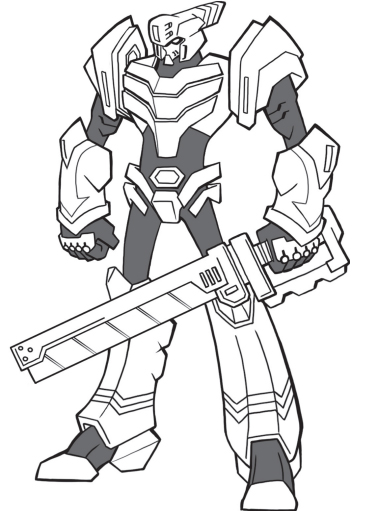
Model: Liberator
Weapons: 1
Armor: 2
Technology: 2
Speed: 3
Bonus Points: 3
Weapons:
Player’s Choice
Configurations:
Pick any two
Special Rules:
Cannot be seen by the Gods
Can Communicate with Any Godblind or Godseeed
May Communicate with the Free City
Can only have Recovery Scenes near Cancer
Yes, some of the setting-unique Models have special rules. As for our Archetype, there's two available to pick.
Mecha posted:
Archetype: Godblind
Strength: 1
Agility: 2
Intelligence: 2
Will: 3
Bonus Points: 3
Skills:
Mecha Combat: 3
Personal Combat: 2
Social: 1
Field Ops: 2
Repair: 1
Medic: 1
Bonus Points: 3
Archetype: Godseed
Strength: 1
Agility: 2
Intelligence: 4
Will: 3
Bonus Points: 2
Skills:
Mecha Combat: 3
Personal Combat: 1
Social: 2
Field Ops: 1
Repair: 2
Medic: 1
Bonus Points: 3
Well it is not much of a choice for us, isn't it? After all, this isn't so much an archetype as it is a background, which we have already decided on. Godblind are slightly better combatants, while Godseed are slightly savvier and social-er. With only one choice of Model and two of Archetype, plus only a handful of points to spend, PCs are going to end up rather samey... There's more options in the other SRS available, though, so this is more a unique quirk from Godblind than anything else. Anyway, Setanta here is a totally badass dude so he spends all his points to raise his Strength and Weapons to 4. Then we'll link stats as follows:
Strength + Weapons = Attack (8) - Self explanatory. We want him to be a powerhouse in and out of his robot, so we take it to the maximum allowed (and possible) at chargen.
Will + Armor = Defense (5) - Because his robot runs on guts and courage .
Intelligence + Technology = Engineering (4) - Because it makes sense, I guess.
Agility + Speed = Movement (5) - See above.
Another problem that becomes apparent now is that at no point have we seen any kind of scale addressing what these numbers mean fluffwise. Sure, someone with Strength 4 is going to be a lot more buff than someone with Strength 1, but what is the human average? Oh well, now to skills. We're already blatantly powergaming so might as well spend the three of them on bringing up both Combat skills to 4.
You might be wondering what the hell Setanta is going to be good at out of combat given he only has a few skills (at low level) beyond his fighting prowess. The answer would be "pretty much everything that is not a listed skill", Mecha assumes that the characters - like those in fiction - are awesome at a lot of things and don't need to roll for anything mundane like playing the piano or being knowledgeable about sciency things so there's no 'roleplaying tax' Skills for us to waste perfectly good points in. Honestly while I do agree that no rules is better than bad rules, good rules are still better than no rules. But this works I guess.
On to Configurations! Our Liberator is a great example mecha because it lets us choose anything, so let's go into the list of Configurations to pick two of them. Remember that each has two personality Traits related to them, of which we must pick one from each Configuration.
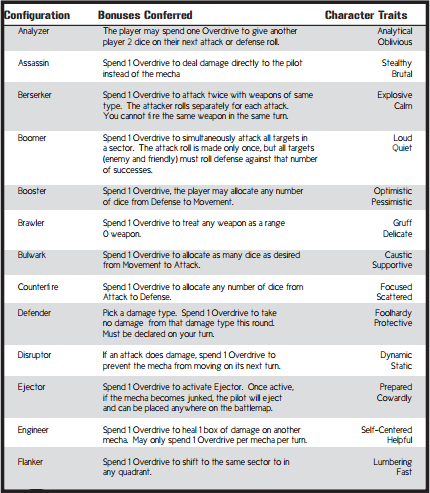
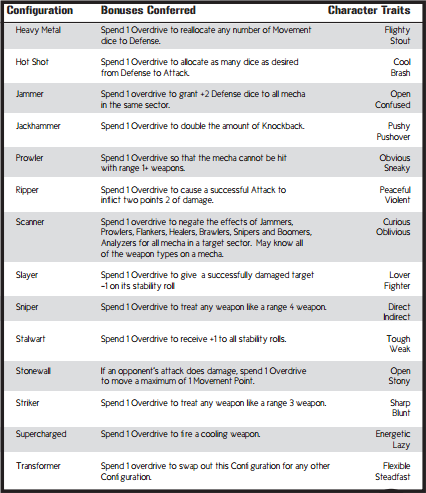
Setanta is a pretty straightforward guy, we are not going to have much tension between what we want to roleplay him like and what we want his bioarmor to be capable of, I figure that we can't go wrong with a combination of Berserker and Defender, choosing Explosive and Focused as Traits. Dude is intense as hell, and all too easy to send into a mad battle frenzy. Also, both abilities are absolutely insane when paired together with his stats, so that is cool too.
Configurations do have a short three page section describing their individual rules more in detail, as well as an IC quote related to their use. What they don't have are tips on roleplaying their Traits, which might have been helpful with some of the weirder ones (like "Dynamic" and "Static") or perhaps in distinguishing all the others that are very similar (like "Violent" and "Fighter") alas, we're on our own there.
Our Archetype does not limit our choices of Traits in Godblind and we need two more of them so we'll make up Hound, because he's protective and fiercely loyal, and Ladies-Man, because I need an excuse to spend AP on things that aren't combat related so as to not cleave the game in twain.
We need four Weapons now, but you know what? Setanta doesn't need actual multiple weapons, all he needs is a spear, so we'll take advantage of the effects-based nature of the game to give him a single spear with multiple uses. We'll make it so that the spear can switch between plasma and physical modes, while at it, justified because nanomachines.
Armor-Melting Pierce (1/Energy)
Seven-Barbed Thrust (1/Impact)
Shockwave Swing (3/Sonic)
Deathblow Throw(6/Missile)
That's right, his spear is so awesome that it can regenerate itself after being hurled and exploding like a bomb. Setanta's general battle tactics here focus on closing in so that he can combo two attacks in a row after spending an Overdrive. Also, we can fluff Counterfire as awesome spear maneuvers that can block anything from another melee attack to a point-blank flamethrower to the face. Oh, and you may have noticed that the Sonic weapon type is a new one, this is because Godblind adds the Wave, Water and Sonic types to the default three - I'm not sure what the difference is between a Wave and Sonic in-setting but there you go.
We're already in the home stretch, the most important thing left is a Goal and then a Protocol. As a Goal, I think young Setanta would like his heroic deeds "To gain everlasting fame." and we'll add some tension in the form of the bioarmor's Protocol by making it so that "Whomever dons this will die young." For equipment we'll give him one Weapon and some Armor. Finally, Setanta gets a single point of Overdrive, and we're done! Let's close this update with a look at the character sheet as it stands.
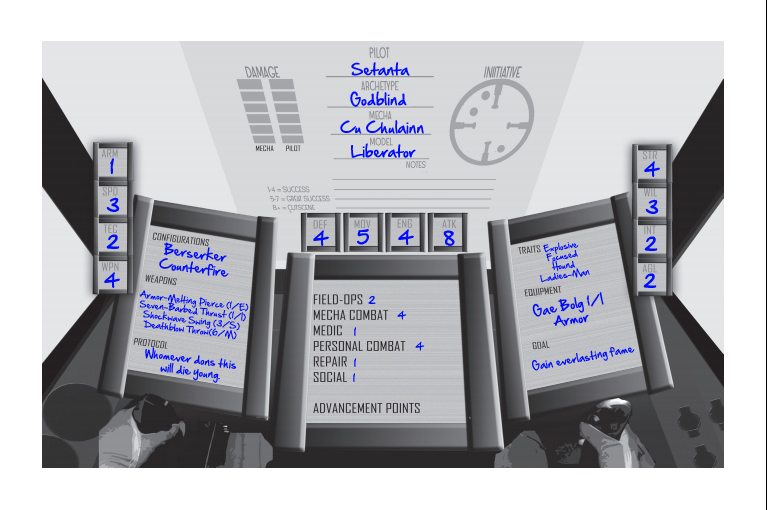
You know how I never said anything about the Mecha needing a name too? Well, neither did the book!
Coming up Next: I rush through this same process with the two other SRS.
U SRS? Part 2
Original SA post
Mecha: U SRS? Part 2
Godblind gave us a good enough example of character and mecha creation for us to go on with the rest of the book, but I might as well show you what the other two SRS have to offer.
Second of three is Steel Gunner Destiny Tomorrow, because incredibly silly names are par for the course in this genre. Set far in the future, long after the Earth is gone in the Destiny Arbor solar system, it focuses in the conflict between the monarchic Arbor Defense Force and the democratic Separatist Guard, which puts half the system into conflict with each other. You can play either side of the war. It says is inspired on Gundam for the most part.
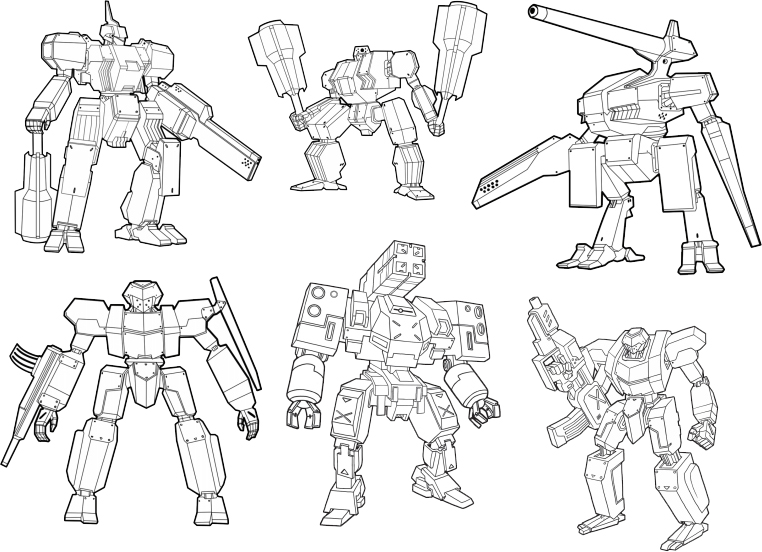
These are our models which I'm getting all out at once because they're really boring. We've got general use (Grave Hound, top left), artillery (Howling Dragon, top right), meleeist (Break Wolf, maracas guy), speedy midranger (Dust Cougar, bottom left) stealth (Ghost Fox, down right) and finally the support guy with the radars and whatnot (Battle Crane, mid bottom)
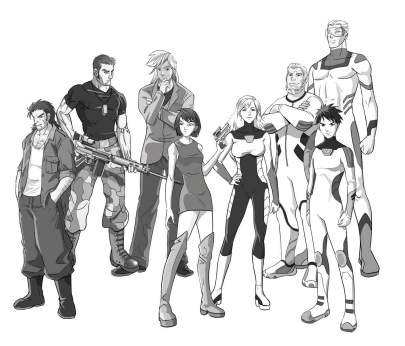
And these are our archetypes. Or some of them, anyway, not all of them have full body pictures. They come with two Traits already chosen for them so we only have room to customize the ones from our Model (which does have its Configurations already in place), this feels less like making a character and more like selecting pregens that the DM hands out at this point. We have the following:
-Hotshot, good at beating up things
-Mentor, intelligent and good with people
-Dangerous Beauty, hardboiled and social-y
-Reformed Criminal, a well balanced dude
-Spec Ops Commando, like the hotshot but better at beating up people than robots
-Spy, the field ops specialist
-Media Darling, almost a copy and paste of the Dangerous Beauty
-Gearhead, super smart and good with robots
-Jaded Veteran, very much like the Reformed Criminal
-Naive Cadet, who takes balance to the extreme having 2's in nearly everything
-Noble, see the Media Darling
-Accidental Hero, the only agility and mecha combat specialist for some reason
Looking back at all this stuff. I really wonder why they bothered to do all this when they could have just given people solid character/mecha creation rules instead. Special mention gets the Esper special ability which... doesn't really do anything special, it just says a psychic character should take a "Psychic Howl (Psychic/3)" Weapon for both themselves and their robot.
This SRS is honestly pretty bland, the models and archetypes mostly reflect that, but the next one is... well, it goes by the name "Special Research School" (SRS, get it?) and it is highschool with american-football themed robots. I am completely serious. You play several years of being a high school student at a dorm and sometimes you get on robots to play football against other schools. This all takes place in Japan for some reason - sorry, New Edo .
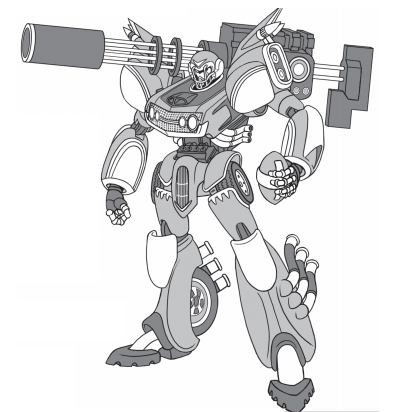
Just in case you still doubt me. I don't know you but this is my favorite design in the entire book so far. Special Research School is really out there, but I'll be damned if it doesn't have cool designs. Anyway, this guy is the Quarterback, and most disappointingly he doesn't turn into a car by default - nor do any other of these models, but all it takes is giving them the choice configuration.
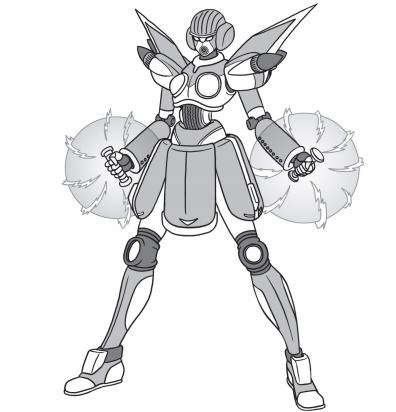
This here is the Cheerleader, who has arguably better combat stats than the Quarterback, oddly enough. Speaking of which if you're wondering how this thing is supposed to contribute to a football match without breaking the rules then hang on, because we still have to get to the rules.
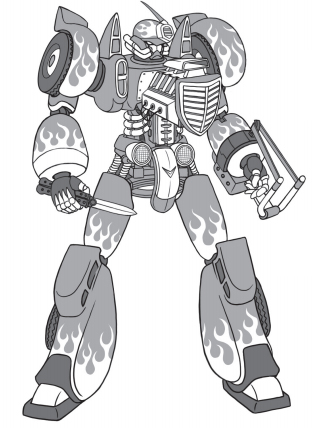
The Hooligan here is a melee powerhouse, not much else to say other than that yes, that is a mecha size slingshot he's got there as a weapon.
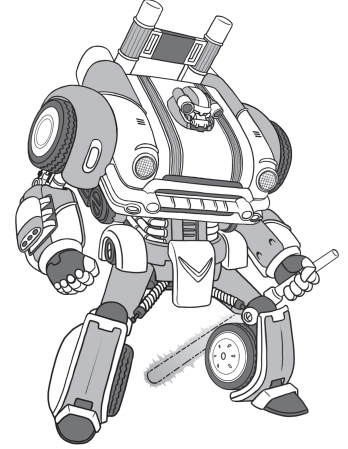
This dude here (The Mastermind) is stated to have lightsaber, also a written speed of 21 . Did I mention this book isn't very well edited? I haven't been mentioning the less gruesome mistakes but this one is of the 'I never bothered to playtest these guys' variety and that's my pet peeve, so I'm bringing it up because I'm a jerk like that. We also have the pictureless Athlete, Lineman and Classmate models too. But we don't care about those because they don't have badass art.
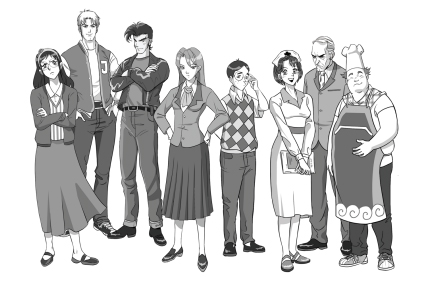
Now for the predictable archetypes. This time there's only four of them and they come with "Trait Groups" instead of predefined ones, the models also let you pick any two Configurations for themso you get to actually choose something about your character's personality. They're the Jock, the Geek, the Teacher's Pet and the Rebel. I'll leave it to your imagination to guess what each of them is good at. The art here also features some of the prewritten NPCs, of which there's a ridiculous number, and they all have their own robots by the way, though there is no fluff for them beyond a few weapons for the most part.
I'll be going more in depth into both SRS later, but in the meantime choose a model and an archetype from either SRS for me to build and pit against our Godblind PC when we get to the combat rules.
Coming up Next: The actual rules of the game!.
What do you mean there's things to do outside the robots? Part 1
Original SA post
Mecha: What do you mean there's things to do outside the robots? Part 1
The rules are pretty simple. Your stats are your dicepool (When piloting, use linked stats) and your Skill rank is the number you want to roll under to do well at that particular skill. Dice that pass are Successes, dice that fail are Misses. It is important to note that 1's explode, as in, you can roll them again and any additional Successes gained will stack. If you get at least five, then it is a Great Success and you will earn yourself a point of Overdrive. If you got eight or more Successes, then you have just caused... a Cutscene.
A Cutscene gives you the right to narrate whatever the hell you want as long as you make it totally awesome and you gain a bonus half action with a bunch of benefits that we won't make sense out of until we learn how combat works, but they're pretty sweet (and kind of snowball the rest of the combat afterwards, honestly). Most of the time a single Success means you have done well enough, but certain skill checks need a specific number of Successes known as the Target Number , which is assigned by the GM. Some other rolls are Contested, such as Attack vs Defense rolls, and the guy with the most Successes wins out in those.
An important caveat is that Overdrives cannot be spent to make regular Successes into Great Successes nor Great Successes into Cutscenes, this means they will give you extra Successes but not the full effects, not even if you spend a dozen Overdrive. Speaking of them, Overdrives are the most important resource in the game, as they can be used to both gain one Success per point of Overdrive spent and let you activate your Configurations. Once spent, an Overdrive is gone, they do not replenish automatically like Action Points or Fate Points or most other equivalents you can think of. So how do you gain them? Well, you start with one, and there's three ways to gain extra.
-By succeeding at a Social Scene.
-By getting a Great Success (the most common method by far, thus leading to the snowball effect I mentioned previously)
-By spending 1 Advancement Point to gain 2 Overdrive.
It is important to note that the GM also has a pool of Overdrive for their NPCs, starting at the number of players minus 1. They also gain Overdrive when a non-mook NPC rolls 5 or more, though they do benefit from Cutscenes the same way PCs do - naturally so do important NPCs. In the case of allied NPCs, they have their own separate pool to spend only on themselves.
Coming up Next: Hold on a second, what the fuck is a Social Scene?
What do you mean there's things to do outside the robots? Part 2
Original SA post
Mecha: What do you mean there's things to do outside the robots? Part 2
After conflict resolution rules we get to The Play Structure .
The first thing we are introduced to here the game's time units. Mecha establishes that the typical RPG Campaign is like a season of anime episodes, usually played throughout several sessions, said sessions in turn are divided into one or more episodes, and finally, episodes are divided in Scenes.
There is a number of Scenes equal to the number of people sitting at a table. Everyone gets a turn to have a Scene, starting from whoever is to the left of the GM and going clockwise. Afterwards, the GM gets to have a Scene themselves, and mecha combat follows that up. So what does having a Scene actually mean? Well, there are several types of Scenes to choose, and each one is meant to have an objective chosen by the player. At the end of a Scene, a skill roll is made to see if the PC succeeded at their objective or not, the Scene is wrapped up and someone else gets their turn to shine.
The GM's scene is meant to bring everyone back together by weaving them all into a single plot thread, then introducing whatever baddies our plucky heroes will have to face in today's episode. An interesting thing about Mecha is that it has an in-built combat objective mechanic into mecha scenarios, so it is easy to make the PCs lose without risking a TPK, as such the game suggests that if the GM is the one to win they get to declare how the battle ended, hopefully making the lives of the characters harder - otherwise the players should suggest a good way to save the day.
To Declare a Scene, a player must choose one of the four types available (Social, Field Ops, Repair, Recovery), frame it (decide where it takes place, who is there, you know the drill) and then pick an objective for the scene (usually something that plays to their Traits or works towards accomplishing a Goal/Protocol) you don't need to call out the objective beforehand, you can just figure it out along the way, but the GM needs to know about it before the roll is made.
That's when the GM gets to assign a Target Number to this story objective. We have a handy little chart here to help us with assigning difficulties, with the traditional caveat that the quality of roleplaying should make them easier or harder at the GMs discretion.
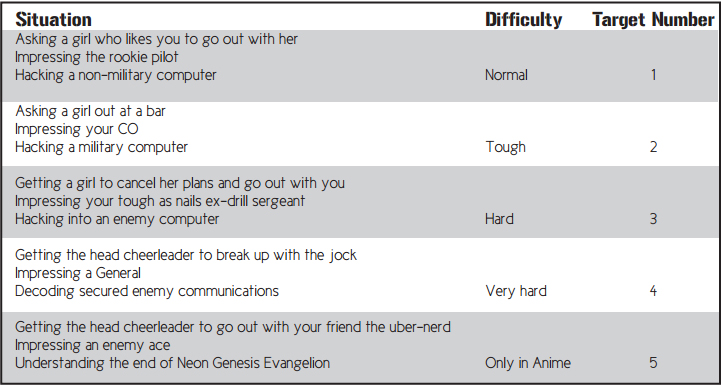

Anyway, Scene Types! There's a short entry for each including a brief description of what they're about, the skill they use, two or three example objectives (half of which are about asking someone out, seriously even the example recovery and repair objectives are about asking the nurse or chief mechanic on a date) a few ideas for using them to develop a character, and what they were used for by the people testing the game.
But really, if you're going to write overly broad skills and tell players to let loose with declaring scenes they get to define themselves, please try to make half the examples in the book not be the same damn thing all the time, and please show how you could use said skills in a way that is actually interesting. Thanks . Moving on...
Social Scenes use the Social Skill, and the objectives tend to be roleplaying oriented. We get some suggestions for their use, too, which basically amount to talking a bit with other PCs and NPCs. If you pass the Social check, you gain a point of Overdrive.
Field Ops Scenes use the Field Ops skill, the objective is to gain an advantage over the enemy on the next battle. The character development suggestions tell us that Field Ops Scenes let us show our character's sneakier side, and even though they are individual by nature they do mention to not be afraid of inviting other people to be sneaky together with us - they don't get to roll though. If we succeed at being cool spies, we gain a Tactical Point. We'll see what those do next update.
Recovery Scenes require the Medic Skill, and they are usually hospital scenes of some sort. They work a bit differently in that someone else can make the Medic roll if they're brought into the Scene, which means there is no reason for anyone but the
Lastly we have Repair Scenes , governed by the Repair skill. Their function is evident, and they work much like Recovery Scenes do, but we actually get rules for repairs beyond 'people just heal' this time around. Each Success will fix up one Stability Box, and two successes can be used to bring a broken Configuration back online. This is, as far as I know, pretty much how Recovery checks are supposed to go too (sans repairing Configurations). What really sucks here is that, since Repair Successes matter so much more than those in Recovery Scenes do, you really want to leave it all up to the repair specialist.
And those are the four types of Scenes. It is worth noting that you can have multiple skill rolls in one Scene, and even have other PCs roll around their own skill checks during your own Scene, but only one check will count towards your objective and each PC may not make more than one check for an objective per episode. If you don't know which kind of Scene you want to do, you should ask the rest of the group for ideas or let someone else go before you. If you still can't decide, roll 2d6 and consult the following table!
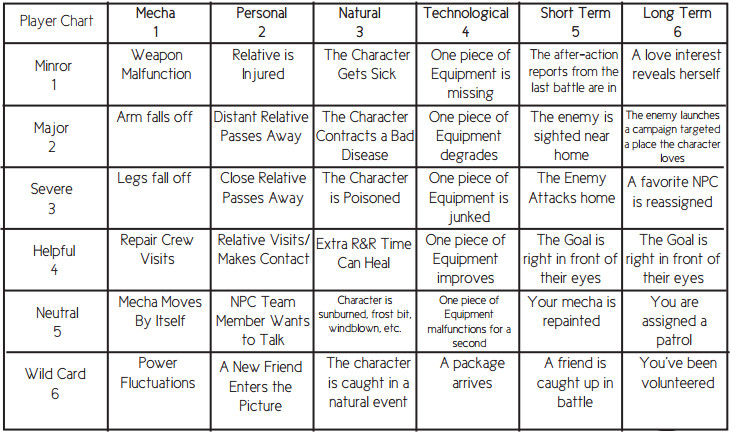
You may notice that many of these don't actually translate to objectives or Scene Types directly, so if that's what you weren't sure about... well, you're on your own! Next we get some more guidelines on roleplaying Scenes, what to do when it is not your turn, how to handle multiple people taking their Scene together, another seduction example, and mostly a repeat of previous paragraphs or common sense solutions to potential problems. Only at the end do we get a mention of incorporating Goals and Traits to Scenes, but it doesn't actually say anything, just that objectives give you a great excuse to earn AP through them.
When the GM gets their turn to do set a Scene, they have to somehow tie all this stuff together into something coherent or to get everyone back together for combat. Preferably both, but in a pinch the last alone will do. We get a few hints on how to do this, though they are a few pages back.
Mecha posted:
1. The “meta” storyline. Every SRS has at least three, if not more, storypoints which can be used to provide major turning points in the story.
2. The GM’s own story. The GM can, at her leisure, use some, all, or none of those storypoints to tell her own story.
3. Loose threads from player scenes. If the player suddenly brings up his long lost sister, there’s no reason not to incorporate her into a GM scene at some point during the game.
4. The Random Event table. Need an idea? Roll D66 and consult the GM Random Event table and let your imagination fly.
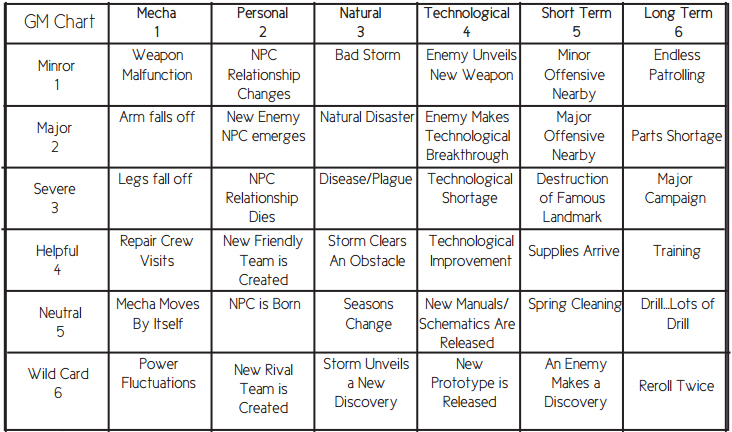
This isn't exactly genius advice we're getting here. I mean it is easy enough if you're already a good GM, but given how little crunch there is and how vague some of the rules are, you'd hope that at least the advice would be solid enough to give someone struggling to get better at this cooperative storytelling thing a foothold.
Coming up Next: Fighting Robots!
Clash! Burn! The giant robot battles are here! part 1
Original SA post
Mecha: Clash! Burn! The giant robot battles are here! part 1
Mecha is better played with miniatures and a map, but not the traditional kind of map, oh no. Mecha uses the Bullseye Battlemap which... well, gains points for originality, at the very least.
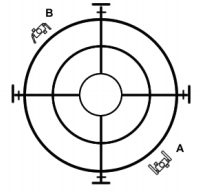
How the fuck does this thing work? Well, it obviously is not a realistic portrayal of a battlefield, it is an abstracted representation of where everything is in comparison to the mission's Tactical Waypoint . But I'm getting ahead of myself.
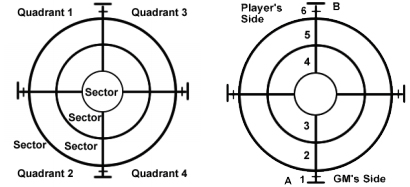
The way it works is that it is divided into quadrants, which have each their individual sectors, but share a central one. Note that the area outside the circle is also considered a sector within each quadrant as well. The numbers denote how far away things are for the purpose of calculating distances. Diagonals are NOT worth double, so if you're at Quadrant 1 and want to attack someone at Quadrant 4, the range is just the same as if you were attacking someone from Quadrant 3. Multiple units can occupy the same sector.
At the beginning of a battle, you determine your starting position on this thing. You can do so by choosing a corner to represent each individual side (as in the first example picture) or randomly by rolling 2d6. In that case the first die determines your side (A for 1-3 and B for 4-6) then the second die determines your sector. Apparently you get to choose the individual quadrant within those parameters, which is very useful as you will see soon enough. If you take the other side by surprise, you get to choose where you start on your side of the board and the enemies are all bunched up in their own corner, at the GM's discretion they may also lose their first turn.
At this point the GM also places down anything worth of note into the various sectors, such as key terrain features or useful buildings. Then they place the Tactical Waypoint . The TW represents having the higher ground, to such a ridiculous degree, that it will secure victory for whoever controls it at the start of their turn from round 2 and afterwards. I'm not kidding, if you are standing on the Tactical Waypoint at the beginning of your turn and it is not your first one, you win. The Tactical Waypoint can represent an escape route, headquarters, or anything else you can imagine. The GM gets to declare whether the enemies retreat or are destroyed, and no PCs can die from losing this way.
The TW means that combat in Mecha is a frenzied King of the Hill showdown for being the one in control, specially because as you'll see, actually killing enemy dudes is pretty hard. I honestly think this is a pretty cool idea, though it has a few problems.
Firstly, you'd think this Waypoint would be located at the center of the battlefield, the maps' bullseye so that all sides have an equal opportunity at taking control of it, right? Not really. You randomly roll 2d6 to determine its location.

I don't know why you'd go through the trouble of coming up with your own unique battlemap scheme if you're not going to take advantage of its most obvious feature (the goddamn bullseye!) but what is more important is that if the second die comes up as 6 then the lucky side it is on will have one hell of an advantage.
This is when Tactical Points (the ones you earned from Field Ops Scenes, remember?) come into play. Each TP lets you move the TW or any number of mecha (enemy or friendly, doesn't matter) one sector within the same Quadrant, or two TP to move from one Quadrant to the other. You're not going to gain much from this unless your whole group goes at it.
And so we come to the second problem with the King of the Hill gameplay, abusing TPs is honestly the most sound strategy in the game. You can either play fair by doing whatever, or gain an overwhelming tactical advantage by having everyone do Field Ops and win combat by the second round. If you can pull this reliably, you will never need more than the occassional Recovery or Repair Scene, either, so it is kind of broken.
Anyway, Combat takes place using rounds, turns and initiative as you expect a roleplaying game to do. You roll for Initiative using Engineering as a stat (It does not list a skill to use as a target number, so I assume you're supposed to hit your Mecha Combat skill) and whoever has the most successes goes first, which, unfortunately, is absolutely all that Engineering can do for you. So if you're wondering if there is an obvious dumpstat in this game, that is definitely Engineering. On the plus side for anyone who didn't dump it, if you do get a Cutscene from this by rolling 8 successes you get to take the enemy by surprise with the bonus half action from it. So I guess if you really want to abuse Waypoint Control, you should get someone to max that. Surprise rounds count as round 0, though, so you still have to actually play the game against someone else for at least one real round before cheating out a win.
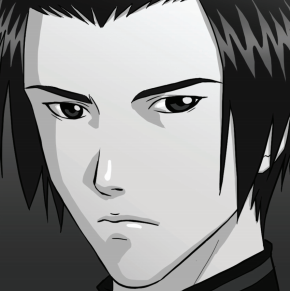
Have a random image as breathing room between all my
 .
.
Let's talk Actions
Every character gets a "full combat action", which consists of one movement roll and one attack roll. If you want to move or fire twice in one turn, you need to use a Cutscene or a Configuration. You can, though, opt to either not move, not attack, or hold their action to a lower initiative. The term half combat action refers to either moving or firing but not both, so when you have to sacrifice one of those, the choice is yours.
To move you make a Movement roll, based on your movement stat and your Mecha Combat skill, and your successes is how many Movement Points you've got. You can move using said MP at the same cost used for TP, which is to say it takes 1 MP to go to a neighbouring Sector and 2 MP to move to a neighbouring Quadrant.
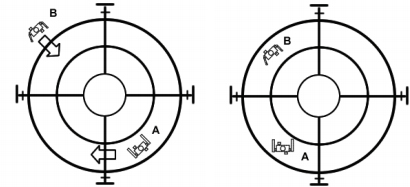
Like this. Dude B spent one MP to move one Sector within the same Quadrant, while A moved in a straight line towards another Quadrant for 2 MP. Pretty simple. The caveat is that you can't move two Quadrants in one round, though. This further complicates things if one side happens to get the Waypoint solidly on their field. Any MP that you do not spend by moving is stocked into a 'Strafing' pool. We'll see what that does in a minute when we get to...
Attacking
The first thing you need to do before attacking is to choose a Weapon. All Weapons can be used at any range, but if you've been paying attention they all have an optimum Range between 0 and 6. If the target is exactly that many MP away, the weapon attacks at full power, and you make a roll of your Attack stat with Mecha Combat as the target.
If you're not at optimum range, then you lose one die for each point of MP you're away from it. In the picture above, dudes A and B are at range 2 from each other. In the picture below they're at range 0.
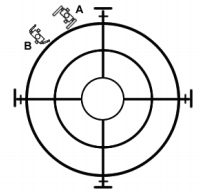
So you roll the corresponding dice, and the defender rolls their Defense stat against their Mecha Combat skill. If you get more successes than they do, you deal a point of damage and knock them back in a direction of your choice up to a number of MP equal to the attack succeses exceeding past the defense ones.
Remember how unspent movement points become a "strafing pool"? Yeah. You can spend those to gain that many extra Defense dice against any one attack. So if you're already sitting under the waypoint, you can spend a "half action" to boost up your defenses and be even harder to knock out of the way.
Attacks cannot do more than 1 point of damage each, and for each point, the defender must check one box on its Stability track - they have 6 boxes, there is also a track for the pilot too. And then they roll a stability check, this is a simple 1d6 in which they are trying to roll over their current boxes in damage. If they pass, things are cool, but if they roll the same or under their current damage then they must choose: be knocked out from the battle and sit out for the rest of combat, or go into Severe Damage status.
Upon entering Severe Damage status they must immediately lose function of a Configuration of their choice until it is repaired via the appropriate Scene. If they take damage again, they must make another check and if they fail this time they will get the choice to bow out or to lose their other configuration and go into Lethal Damage status.
When this happens, the pilot fills up their own stability track all the way to 6 and gains a point of Overdrive - this makes it five ways you can earn them, rather than four as the Overdrive section mentions. Should they fail another stability check, they go kaboom and the pilot dies.
It takes 3 hits minimum to kill any non-mook, potentially 8, since it is more or less entirely dependant on luck only one configuration can heal people and only another helps you resist stability checks. Thus, playing ping pong with your enemies and rushing a King of the Hill win is much more convenient than trying to blow up everyone else.
(I wish they had given Engineering an use here, perhaps as a stability track stat, or as a stability pool, it would make sense for it to help manage damage taken somehow given the name)
Anyway, there is another rule to keep in mind, and that is Weapon Cooldown. Basically you cannot use the same Weapon two turns in a row. If you've used multiple weapons in the same turn because of a Configuration or a Cutscene, you still cannot use them next turn. This adds a bit of much needed variety to the gameplay, so I'm okay with it.
Coming up Next: Odds and ends of mecha combat rules.
Clash! Burn! The giant robot battles are here! part 2
Original SA post
Mecha: Clash! Burn! The giant robot battles are here! Part 2
Let's wrap up how combat works in this game with more poorly thought but easily fixed rules. Starting with...
Taking the Bullet
If you share a sector with an ally you may declare that you are Taking the Bullet and giving them cover. Once this is declared neither Mecha may move, strafe, or use Configurations which prevent strafing. On the plus side, whenever the covered mecha would be attacked both of you roll Defense and use whichever result is higher, if the defense fails the attacker chooses who takes the damage. This takes 1 Movement Point so I guess you have to declare it in your turn, so no heroically jumping in at the last minute! The covering mech may be dislodged by making a successful Attack from the same sector.
Let this be our final battle!
Instead of rolling for Movement, you may instead declare that you want to retreat from the battlefield. If no one else protests, you will pull out from the battlefield after your turn is over (Yes, you do get one last attack in) the funny thing is that anyone might feel like calling out "Let this be our final battle!" and make a contested Movement Roll. If the fleeing mecha loses, they may still move as normal for the turn, but they don't retreat.
Pilot vs Mecha
Combat for Pilots is pretty much the same thing but without linked stats, the character gets to use the stat they linked to Mecha Weapons as their pool instead. The same logic applies to Defense, Initiative and Movement. Death to Ability Scores! Pilot Weapons suffer from cooldown like the ones for Mecha do, but they also have that Range 0/Impact type unarmed attack.
Just like Mecha hurt each other 1 point of Stability at a time, Pilots always deal 1 point of Damage to each other, and the same also applies to a Pilot attacking a giant robot or the giant robot attacking someone on foot. This way, enough dudes with rocket launchers can take out a robot. Any time a Pilot is damaged (as a result of the mecha entering Lethal Damage or the use of the Assassin Configuration) they have to make a 1d6 Stability check, this works much like with the mecha equivalent and should they fail they are knocked out and out of combat. There's actually no mention of whether or not people can die from this, although it is implied that once they run out of stability boxes they probably buy the farm, given the player-empowering nature of the game it might as well mean that they just fail their next stability check and pass out.
If a character finds an unboarded Mecha in their same sector, they may use their Movement for the turn to jump into the cockpit and take control, then spend their other half action to start up its systems.
Terrain
Terrain gives a specific sector some properties that affect combat, the rules are pretty simple. Buildings can be located in sectors on top of terrain too, and may have stats just like mecha do (except that their Movement is always 0) often they also have Weapons and Configurations as well, but if they ever fail a single Stability Check, they crumble and are destroyed.
Five Example terrains are included as templates for prospective GMs to use as inspiration, which frankly you should only as that, because they're all terribly written:
Corpse of Trees - It costs two MP to enter this sector, but it grants a +1 to Defense rolls. However, Wave, Fire, Laser or Plasma type weapons (half of those don't even exist!) will set the sector on fire. It does not say whether this happens when you attack someone in there automatically or if you have to spend an attack doing so. Anyone who enters the burning sector must defend against a "Level 4 Attack" from the GM. I don't think attack levels are mentioned anywhere else in the book so I'm going to assume this means an attack with a dicepool of 4. By RAW you don't suffer any damage if you're already in the forest, though.

Fog - Attacking anything at range greater than 2 suffers a -1 penalty. That's all it says, so presumably the effects apply no matter which of the two is in the foggy terrain, or if the fog is just in between them.
Hills - It costs 2 MP to enter Hills, but you get a +1 to attacking anyone who is... in the same sector. You also take -1 to Defense when in Hills because you're easier to spot and shoot from anyone over range 0. I guess the concept of higher ground does not apply here. Theoretically they give you 'excellent line of sight of the bullseye battlemap' but there's no rules for such a thing so this is pointless unless you want to get crafty by making them ignore other terrains such as fog or the defense from a corpse of trees.
Mountain - Mountains are impassable and block line of sight. Hope the Tactical Waypoint doesn't spawn there!
Office Building - I'm just going to quote this one. Here.
Mecha posted:
Example terrain: Office Building
An office building is a typical, non-descript building found in suburbs and cities everywhere.
Bonuses and penalties:
It costs 2 Movement points to enter a sector with Office Buildings.
Office Buildings have an Engineering rating of 2, which gives them 4 damage points. They are destroyed when their Engineering drops to 0.
They may also have a Defense rating as well. Impact weapons do double damage against buildings
The implication here is that Engineering was an HP stat at some point, and they forgot to edit this one mention of such a thing out.
 It is worthy of note that the "Impact Weapons do double damage" thing wasn't mentioned in the proper section for buildings so it is up to you whether that applies to all buildings or just this one, I guess. Its not like I'm paying money to have you people save me the trouble of making my own rules or anything.
It is worthy of note that the "Impact Weapons do double damage" thing wasn't mentioned in the proper section for buildings so it is up to you whether that applies to all buildings or just this one, I guess. Its not like I'm paying money to have you people save me the trouble of making my own rules or anything.
Enemy Types
As previously mentioned, Allies have a separate Overdrive pool, but all enemies have a common Overdrive pool to draw from and contribute to.
Mooks - These travel in squads, typically of five mooks per squad, each success you get on your attack roll will kill one Mook from that squad. They get two default Weapons. Mooks come in three categories that give them attack and movement pools, so I guess they don't have any defense or initiative at all.
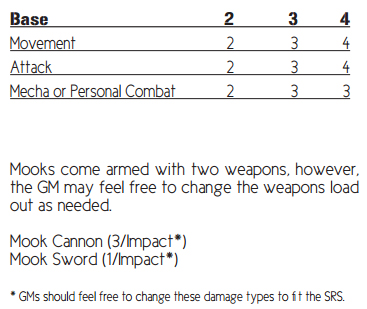
I like how they made a table just to say "Both stats and skills go from 2 to 4", I wish these people had an editor.
Soldiers - These guys are faceless nameless grunts just like mooks, but they actually have robots! And they also earn Overdrive! (the Mook writeup kind of forgot to mention either of those!) but they are taken out the moment they fail a single stability roll. Any NPC in the book not specified to be an Ace is a Soldier.
Aces - Aces are like PCs. They have no special rules whatsoever.
So far I've been rather forgiving of how poorly written this thing is, but I am bringing the mistakes up more often now because these are the actual rules of the game we're supposed to be following. We are moving on to greener pastures next, hopefully, as things don't need to be so technical.
Coming up Next: Frenzied Battle! It is Mecha Cu Chulainn vs Class Rep!
Battle! It is Mecha Cu Chulainn vs Class Rep!
Original SA post
Mecha: Battle! It is Mecha Cu Chulainn vs Class Rep!
We need to make someone to butt heads with Setanta, the
The Teacher's Pet Archetype provides this template.
Mecha posted:
Strength: 2
Agility: 2
Intelligence: 2
Will: 2
Bonus Points: 3
Skills:
Mecha Combat: 2
Personal Combat: 1
Social: 3
Field Ops: 1
Repair: 2
Medic: 1
Trait Group 1: Helpful, Dedicated, Creative
Trait Group 2: Know-It-All, Brown Noser, Tattletale
Slightly worrysome here is that she has no free skill points to distribute, a quick look at the other Archetypes provided confirms out that this is just a typo, both her and the Rebel are missing 3 Bonus Skill Points when compared to the Jock and Geek, we are going to give those back. We end up with the following:
Strength: 2
Agility: 2
Intelligence: 3
Will: 4
Mecha Combat: 2
Personal Combat: 1
Social: 3
Field Ops: 2
Repair: 2
Medic: 3
Not much of a bruiser, but she can outtalk, outhink and outstubborn nearly anyone. Now for her robot.
Mecha posted:
Weapons: 1
Armor: 2
Technology: 2
Speed: 3
Bonus Points: 3
Weapons:
Football Launcher (2/Impact)
Configurations:
Pick any two
Favoring brains over brawn, Chinatsu pimps her ride with thinking she's going to play it as a tactical and quick moving type with some fighting prowess but just enough to even out her linked stats. Speaking of linking, her combat stats will thus be:
Attack: 4 (Weapons + Strength)
Defense: 4 (Armor + Agility)
Engineering: 6 (Technology + Intelligence)
Movement: 8 (Speed + Will)
As for Traits, only one of the choices in groups 1 and 2 have any Configurations to go with them (Helpful). While this would usually mean that we're free to do whatever with the ones that will get rules attached to them, Chinatsu does get Helpful and its Engineer Configuration because it makes sense for a bossy type to give off Healing Surges. She picks Know-it-all from group 2 because she knows all the school rules by memory , Intense to represent that is ALWAYS giving her 110% all the time, and Steadfast to grab the Transformer Configuration - because how can you look at that robot and not give it a car mode?
If both characteres had met under different circumstances, they might have been friends. Have a picture of Chinatsu so that we may remember her courageous soul before her inevitable murder.
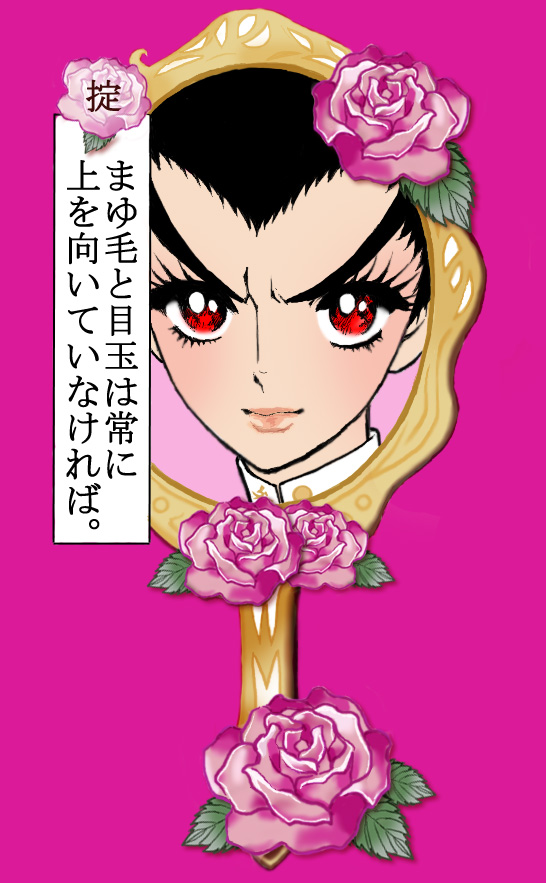
According to Google Translate, Ishimaru is written as "many summers".
Before the match proper begins, I have both of them have a Social Scene standoff to intimidate the other. I am going to roll all of this legit, by the way, so there's a small chance Chinatsu can get lucky and pull off a victory, though it isn't likely. I want to point out that Skills don't have any stat tied to them, and that the stat used for each skill is only implied in the stat's own description, whether this is more poorly explained content or another victory in the name of Death to Abilit Scores is up to the reader to decide.
I also notice just now that Setanta is not actually legal by the rules because he has 4 in both the Mecha and Personal Combat skills (the maximum at startup is 3), that and he also cannot use his Berserker Configuration as-is because both Weapons have to be of the same type (they're all different) so we will fix both of those. We make all his guns of one type and move the extra points to Social getting it to the maximum allowed because it fits with the concept and gives him a chance to best Chinatsu at her own game.
Rolling opposed Will checks, Setanta gets one success and Chinatsu gets none, so the single point of Overdrive goes to him. We roll for the randomly determined Tactical Waypoint next, with Chinatsu being on the Player's side because we sympathize with the underdog here... and it lands in Setanta's mid-outer ring.
Round 1
Thankfully, Chinatsu gets the initiative and uses her four Movement Successes to slid herself one point short of the TW. Since she is at optimum range for her lone weapon, she attacks with her measly four Attack and two MC, which Setanta easily overpowers with his above-average defense. Setanta moves into the TW and gets this trainwreck started with five attack successes (gaining a point of Overdrive) to Chinatsu's singular defense success, she takes a box of damage and passes the stability check... but Setanta is not going to use the knockback from his four other succeses, oh no, he wants to keep her in range for his followup attack. Spending the point of Overdrive he's just earned he gets another attack roll in with his Berserker Configuration, he overpowers Chinatsu yet again (Her lone strafing die amounted to nothing), this time she -does- fail the stability roll though, and she chooses the Engineer Configuration to be sacrificed because she wasn't going to use it anyway. He also adds insult to injury by knocking her back two steps.
Round 2
Chinatsu makes a measly attack roll for 1 Success. Setanta laughs at the foolish girl, and taunts she is one hundred years too early to match him, blowing an Overdrive to activate his Counterfire Configuration he gets a dicepool Defense of 12 and rolls...four successes, he doesn't care about the wasted Overdrive because he is clearly feeling omnipotent here. She then rolls terribadly and has to spend her Overdrive into getting to the TW so Setanta won't win right then and there on his next turn. Spending his last overdrive, he hits the girl once and even knocks her back one square. Then rolls for Movement and keeps the three successes as part of a strafing pool.
Round 3
Once again, Chinatsu fails at doing anything meaningful with her attack roll, but at least moves into the TW to stop Setanta from automatically winning. He hits and knocks her back again. He also gains a point of Overdrive from this because once the snowball begins rolling it does not stop.
Round 4
This is pretty much a repeat of the previous turn, except that Setanta spends his Overdrive to finish this off, she fails the first Stability check and is knocked down into Lethal Damage status, she does gain a point of Overdrive but it is useless since she now has lost her second Configuration and a single Defense Success won't be enough to stop his overpowering Attack roll. Having outlived her odds long enough, Chinatsu's Quarterback explodes and she dies like she lived. burning out her youthful spirit.
Observations
This battle was pretty lopsided from the start. Chinatsu did not max out her good stats at chargen (partly because her mech sucked) and she clearly could not stand up to someone who did, to make things worse getting to the TW would not do much for her if she was not able to stop Setanta from knocking her out of it. His high stats fed him extra Overdrive twice, which he used to get even more attack rolls in for extra overkill.
Chinatsu did have a chance at victory, which would have mostly relied either on getting lucky with the Tactical Waypoint landing on her side or starting with two Overdrives. Setanta's Movement of 4 means that it would take him 2-3 turns to get him in a proper position, so she could have used her Transformer configuration to temporarily turn into a Defender (make herself immune to all attacks of a specific type for a round), Disruptor (prevent an enemy you hit from moving) or even Heavy Metal/Bulwark (turn movement dice into defense/attack dice) as needed, unfortunately she only started with 1 Overdrive and did not gain any more until it was too late to properly abuse her versatility.
Of course everyone can (and thus, should) max Attack, Movement and Mecha Combat skills if possible. Also the crunch is pretty simple, so if you don't care much about all options being balanced, this works fine enough with a few simple fixes to make things less abusable.
Coming up Next: Character Advancement, or more reasons to minmax the shit out of chargen.
Dying is Overpowered
Original SA post
Mecha: Dying is Overpowered
So it turns out our example character Setanta is kind of crazy strong, and I wasn't even trying hard to break the game (Hell, I made a few mistakes trying to go with the rule of cool) so let's see how difficult it is to actually make him impossible to defeat 1 on 1!
Mecha posted:
1. Playing in the session: 1 AP
2. Playing to Character Traits: 1 AP per Trait
3. Making the table laugh: 1 AP
4. Introducing intense emotion because of the story, not by being a jerk: 2 AP
5. Achieving a major goal or passion: varies* AP
6. End of a story arc (GM’s discretion): 1-5 AP
7. Helping the GM to recap the story or refresh players’ memories about the previous session: 1 AP (must be done before the start of a new session)
Also, at the end of each session, everyone is supposed to tell the rest how they roleplayed to their Traits and if people think it is a stretch or he's bullshitting for the sake of extra AP, they can veto it. This would have been a lot better if other people were the ones pointing out how you did (or did not) roleplay a Trait properly, or at least it would go well with the cooperative storytelling vibe of the game.
By the way, I'm not fond of people getting different experience every session for a variety of reasons, but I understand that the goal is a noble one. So instead of ranting about Timmy growing twice as fast as Johnny because one knows how to amuse the GM and the other doesn't, I'll point out the other ways in which character progression is borked.
You can spend your points in three ways: To raise Stats, to raise Skills, or to gain Overdrive. Increasing one of your pilot or mecha stats by one costs twice the new level in AP, so raising Setanta's Weapons from 4 to 5 would be 10 AP. Overdrive costs 1 AP per 2 Overdrive. As for skills, well...
Mecha posted:
To increase a skill, the cost is 5 x the new level. So to increase one’s Mecha Piloting skill from 4 to 5, the cost is 30 AP. Opening a new skill is 5 points (1x5)
That is not how math works, Mecha. Also all skills start at 1 so you cannot open a new skill . Did I mention this book was apparently proofread by RPG.net? Well I am mentioning it right now because that's what the first page has in a big 'thank you'. I don't know if they released a version that fixes all this stuff later, but at least it isn't as bad as The Secret Fire.
Anyway, as you can see this is one of those games where it takes you several sessions to get anything worthwhile for your character. In particular the cost of increasing skills is nuts and if you don't get your good skills to 3 during chargen then I am so sorry for you. So how do we go about breaking things then? Simple, we don't upgrade our character ever. Instead, we spend all AP on Overdrives. See, we could hoard 20 AP through 7 sessions or so to increase Setanta's Mecha Combat from 3 to 4... but why do that when we could get Forty Overdrives instead, and breeze through every encounter forever ?
Additionally, when a character dies and another one replaces it, they get to keep all the AP that the previous character kept, so Cu Chulainn's Protocol of "Whoever dons this bioarmor will die young" is incidentally the best way to powergame AP from the system, along with "I will die a hero" or some such, since you will get AP equal to ALL of your PC's sessions played (twice, if you have the Goal and Protocol combo), instead of the handful you'd get from a more easily achieved Goal/Protocol. If you really wanted to abuse it, you'd do this thing multiple times with a Rei Ayanami-esque character who will not die even if they are killed.
Of course, planning to get your character killed for more AP is a terrible exploit and I wouldn't allow it, nor do I think anyone sane would. Too bad that the death of the PC is still a suggested Protocol multiple times in the book. To add insult to injury, there's this little paragraph next.
Mecha posted:
Also, if the previous character had a Goal that dealt with them dying (for instance “Go down in a blaze of glory” or “Return to civilian life”) the new character can have the AP from accomplishing that Goal. If the previous character’s Goal had nothing to do with dying, then the new character does not gain the AP
If death doesn't suit you, you can retire too! But what if you don't want to abuse the system and pick another Goal/Protocol combo? Sorry then, if you die then it goes to waste! There's even another two paragraphs suggesting you ways to earn a 'dramatically significant death' which basically means you don't even need to die by the rules, just request it out of the GM and they should agree 'if it is of service to the story'.
One last thing to add is that it is possible to change Configurations or Mecha throughout the story like you often see in anime. That's cool, except that the book says PCs must immediately change their Traits when doing so, effectively rewriting their personality. Because you cannot be allowed to use a sneaky mech unless you're sneaky yourself, that would be silly .
Coming up Next: Totally SRS Advice.
U SRS? part 3
Original SA post
Mecha: U SRS? part 3
The next pseudo-chapter handles how to create your own Setting Reference Schematic, given how those are kind of a big deal in this system the advice is hopefully good, right?
It actually is. I give Mecha a lot of flak for its rules, but there's one thing it gets right and that is that the author knows his genre and what makes it tick. Now before you get excited, the guidelines aren't anywhere near as good as those in the Dresden Files or the Buffy RPG, but they're there and - more importantly - they're genre appropriate unlike stuff you may get from World of Darkness or whatever. Anyway the SRS is supposed to be some kind of master document anyone can reference when they need a question answered about the setting. That's not a bad idea, I know I use a wiki or google documents for this stuff, so I'm all for this suggestion.
Mecha posted:
The core Mecha rulebook has three SRSes in the back of the book, each portraying a totally separate set of setting details. However, you may wish to create your own setting. That’s awesome! Do it and feel free to drop me an email about the setting you create
Bonus points for the guy behind the game being actually cool and not some pretentious jerk who thinks his Warriors & Warlocks setting is the best thing since Forgotten Realms that will make him rich. Anyway, we get a questionnaire to fill out to make a SRS, we can do this as a lone GM or as the whole group sitting down to brainstorm cool stuff.
Mecha posted:
The Setting Questions
1. Time period. Is it modern day, the far future, the past, an alternate history.
2. The Nature of Mecha. Are mecha technological, flesh and blood, are they alive? How did they come to be? What type of equipment does a standard mecha have?
3. Availability of Mecha. Does everyone have a mecha? Are they military equipment only? Are they rare? If they’re rare, how did the PCs find them?
4. Models of Mecha. You should create between 5-8 mecha models. You can repurpose any mecha used in this book or any supplement or create your own. Typically, mecha are built with 8 stat points distributed amongst 4 stats with 3 bonus points.
5. Archetypes Available. Next, you should create 5-10 character archetypes. Again, feel free to repurpose any of the Archetypes in this book or any supplement. You can also create your own by allocate 8 stat points amongst 4 stats with 3 bonus points. Again 8/3 is the standard for Heroic Journey Publishing.
6. Determine Traits. Every character starts with two Traits from their mecha’s Configurations. Now, every SRS has different ways to figure out from where the other two come. In Godblind, the players choose their last two. In Steel Gunner, the Archetypes dictate the final two Traits. In SRS3, the final two Traits are selected from two lists. All approaches are valid as are any other ways for determining Traits.
7. History. Outline at least a few major events of the world’s history, especially those which have lead to the upcoming conflict.
8. Religion. Monotheistic, Polytheistic, None, The Force, Gaia, etc. This may or may not have an effect on how the game is played.
9. Political Units. Major Nations, Space Colonies, Tribal Governments, etc. These political units will form the factions for which the PCs will eventually fight.
10. Economy. Feudal, Corporate, Class Division, All Share, Haves/Have Nots. This may describe why the PCs fight.
11. Theme. A theme for the game. What are some of the major messages in the game? Is there a message? Is it only about mecha?
12. Conflict. Who’s fighting? Mecha are kind of boring if they stand there. There need to be at least two (though more is good, too) factions battling it out for victory.
Note how we're finally told how characters are made from scratch without an Archetype or Model, not that it was too hard to reverse engineer. After making sure we as GMs know the answers to all the above (Specially Classes and Archetypes) we need to establish Damage Types (no guidelines are given) whether we want to restrict Configurations or not, and finally to think about the Story Stages.
What are Story Stages? Well, Mecha wants to be played with a clear conclusion to the story it presents, and we get some decent advice on how to pace things from the first Episode to the last. We are going to need at least three Story Stages, each with their Initial Conditions, List of Actions, and Story Milestones. While Story Stages arent' obligatory, they will save a lot of time for you as GM. I cannot endorse this enough, because a ton of people simply decide to wing it which doesn't really work too well for this kind of genre.
I'm skipping a few pages forward into the GM section to go more in depth into this, because otherwise this update is depressingly short and frankly both these sections should be together. Usually in Mecha anime and manga things go like this: A character somehow falls into the cockpit, he or she spends a period of time getting used to their new life and their robot's capabilities, everything goes to hell and someone probably dies, and finally the good guys persevere and triumph often at some kind of cost. Stories where the character starts out experienced skip the first two steps, and some put the third step of making shit get real on loop. You want to mimic those steps while making sure that you have an ensemble cast instead of a single protagonist, all in all this sounds pretty obvious but it is good that someone is bothering to spell it out for non-experienced GMs.
A Few Common Tropes
The next section tells us how to run three distinctive types of games. Those based on Real Robots or Super Robots, as described by none other than tvtropes.org. Now maybe you're reading this without being a mecha freak like I am, and you need those explained to you, so while I think the descriptions there are kind of bullshit we'll use them for the sake of this review.
Real Robots are the ones that function more like walking tanks, a lot of mecha are mass produced and exceptional characters tend to be great soldiers rather than superheroes. These shows tend to pay a semblance of attention to the laws of physics, they run out of ammo and fuel, and are usually about how much war really sucks. Super Robots are more or less superheroes in the form of giant gods of steel, they either handwave inconsistencies away or outright give no fucks about realism. They tend to transform, combine, and generally be a lot sillier than their counterparts. The stories are often more traditionally like the hero's journey and less grim or serious.
These descriptions theoretically make sense, much like GNS theory does, but in practice you will be hard pressed to find a show that is 100% "Real" or "Super". The book acknowledges this, and does mention that good shows actually bring up whatever elements they like from either to tell the story they want. Speaking of stories, Mecha tells us that First and foremost, mecha anime is not about mecha fighting and that Mecha fighting is cool, though you want robots because they're badass, but they're ultimately just a... well, a vehicle for the character's own wishes to change the world and their responsibilities from being granted such power.
Turns out, mecha isn't really that different from any other kind of fiction. Hell, it shouldn't even be called a genre of its own, because the stories told in mecha fiction are the same you'd tell without using robots as window dressing. We are then given a handy list of themes and subthemes we can make part of our game, and we're supposed to roll up a bunch of them together taking our PC's Goals and Protocols into consideration. We get another example here, using 'get a girlfriend' as the Goal. I swear I'm going to develop an irrational hate of PC romance by the end of this review if these people don't get more creative with their examples.
Mecha posted:
• War is hell
• Can pacifism work?
• We’re alike if only we could talk it over
• The older generation has ruined it for the younger
• Technology as a destroyer of hope and the human communication
• Perfection of the individual (usually to that person’s detriment)
• Pleasing a father figure/mentor
• Revenge
• How far are you willing to go?
• Coming of age
• Redemption
• Acceptance of a character into a group
• Alienation of a character from a group
• Racism
• Sexism
• The dangers of nationalism
• Absolute power corrupts absolutely
• Blind trust can lead to your ruin
• Trust in your friends
• Loyalty/Disloyalty
• You reap what you sow
• Sometimes for secondary characters, there’s a strong theme that you don’t have to be in a mecha to effect change
• Things aren’t always what they seem
• People can change (Normally enemy aces switching sides)
• Sometimes, you get the “people can’t change” theme, too
The Prologue
Once we have a SRS and people have made their characters, we should give them a taste of the game proper with a Prologue session. A Prologue is split into two halves: The GM's Turn and Combat.
During the GM's Turn they've got the task of establishing how the PCs know each other, to this end, they... well, they ask for the player's opinions. We get some vague encouragement to establish preexisting relationships with an example that apparently came up in two separate playtest sessions "The classic example is that one character dated the other character’s sister who is now presumed dead." I frankly don't know what the hell this guy is talking about bringing up this 'classic' I can't recall any mecha fiction that uses it. But whatever, on to the good part of this example:
Mecha posted:
1. How did the brother feel about the relationship and about the other player?
2. How did the player in the relationship feel about the sister?
3. Do they blame each other for the sister’s death? Openly or privately?
4. Is the sister really dead?
5. If she’s really dead, is there an alien, ghost, twin, or artificial lifeform that can look like her?
Now if only this creativity could be applied to some additional, preferrably non-dating related examples then I would have more praise for the writing here. As it is, it barely counts as advice on using PC backstories at all. Finally, in the case that your Players are jerks completely devoid of any creativity, we get a 2d6 table to determine relationships.

The Emotion table is repeated, by the way. On the same page, even. Anyway after establishing relationships you need to set the stage, introduce key NPCs, describe the locales, and it even recommends to roll on the GM table for ideas of what kind of stuff should happen before the combat part - we are then told that we don't need to do combat right now, but that if we do it should be easy. Usually during playtests they allowed PCs to have Scenes as normal after the prologue battle to cap off the Episode.
And that's most of the GM advice that isn't related to handling combat.
Coming up Next: More GM Advice.
BRING THE PAIN
Original SA post
Mecha: BRING THE PAIN! Or how to not name a GM Advice section.
The first three pages on running combat are actually about establishing it. The advice is pretty obvious (and honestly rather lazy) to anyone who isn't an jerk or a newbie. Choose things your characters care about, encourage them to go and spur conflict themselves, blah blah. Instead of any useful examples on this, there's a handful of stories about the author's personal character and more from the asshole who chose to have "Get a Girlfriend" as a Goal. Sometimes I think half the writing in this game is copied and pasted from a dating sim RPG, it is the only way I could see someone making every example of anything a PC might ever do in a game about giant robots be about dating.
Obligatory eyerolling after yet another good opportunity to give people concrete and useful advice was wasted, we're told that different games have different needs as far as combat encounters go. In a SRS like Godblind the characters are fighting all the time and they use up their other scenes to prepare for their next strike, in Steel Gunner there's plenty of room for PCs to trigger enemy action as well as to go out looking for it themselves, and we're told that in Special Research School most conflict is internally generated so the author would virtually not prepare at all.
Seemingly 'random' encounters can (and should) serve a purpose, if the PCs encounter enemies on patrol then you should establish their utility to the story (enemies on recon, friendlies piloting enemy mecha, etc) at some point. And of course the Story Stages present in each SRS are there to give you advice on when enemy factions should get their own plots going and stuff. There's three kinds of battles: Skirmish, Even Battle, and Desperate Stand. Skirmishes use opposition weaker than the PCs and are there to give them a breather after a big fight, to get a feel of new characters and mecha, and when you want to have them 'earn' their next plot coupon after taking it from NPCs. An even battle is... well, even. Lastly, the big fights are the ones where PCs can only win by getting lucky with the Tactical Waypoint, because being outnumbered and having tricky configuration combos thrown at you is hell in a game with this little in the way of rules. Mooks are there to make PCs waste turns blowing them up, also to stand on the Tactical Waypoint and force PCs to get moving there as well, lest a lousy Mook win the battle for the GM.
You can break up particularly large battles, like those at the end of a story arc, into multiple episodes. Beat up some bad guys, have some Scenes in between, then proceed with the next battle of this large scale operation. But slightly more interesting is that you can interrupt ongoing combat with Scenes, and not all of them need be flashbacks either, the example given is... about a player who was dating another's sister and both want to convince her to stop fighting. Taking into consideration that the book actually says "player" there instead of "PC", by now I am certain that everyone in these playtests did nothing but hit on each other. When said Scenes are over, combat continues as normal.
Next up is advice on running separate combat scenarios, using two Tactical Waypoints, for those times when the party splits up because they love to make the GM's life harder. Lastly we are told how to use our common pool of Overdrive best, the author generally doesn't use Configurations much, and instead spends Overdrives to add successes to attack or defense rolls continuously. Since you've got a lot of NPCs, you should be earning a lot of Overdrive and can afford to spend them often.
Coming up Next: Running the three SRS.
Cast in the Name of God
Original SA post
Mecha: Cast in the Name of God.
We've already had a bird's eye view of Revolution Deity Godblind, the biopunk-ish game where you ride suits of bioarmor in your quest to destroy the oppressive tyrants of the Living City. Before we go more in-depth into what a game of Godblind is like, here's a quick refresher: Your PC is either a Godblind (someone whom the Gods' all-seeing eyes cannot find) or a Godseed (one of their rebellious progeny) with that said have some art of what each might look like.
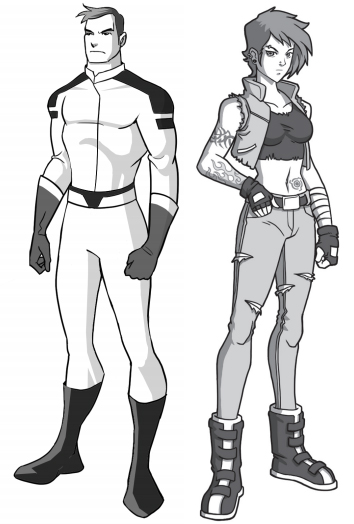
Enemies include not just the Gods themselves, but also their various servants - usually humans brainwashed into being mindless warriors itching to make heads roll. Said humans are buffed up with nanomachines to the point that they can go toe to toe with the PC's Liberator bioarmor, we have two example statblocks for two such example enemies, of the male and female variety.
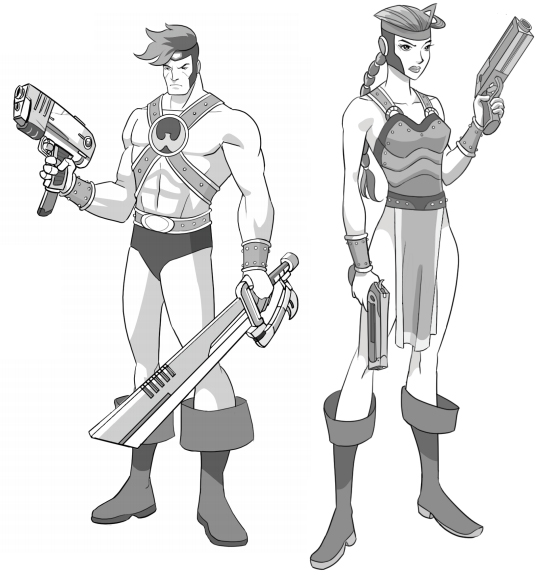
Both have a number of bonus points to redistribute as the GM sees fit, but the odd thing is that they do not have stats as people, only as robots, and the numbers given from each linked stat are lower than the model's base. I have no goddamn idea what this means, but apparently He-Man here has maximum strength with crap speed, while his counterpart of the fairer sex is more balanced with a focus on speed and mobility. I guess the Gods aren't too keen on gender equality.
Fortunately, we do get some NPC Archetypes for male and female warriors as people later on, as well as an example of how to link the stats for each. Kind of should be on the same page as their model, but whatever. We then get some finished arrays for premade Enemies:
Female Artillery - With midrange area of effect attacks.
Female Silent Knife - With Prowler and Assassin.
Female Long Shot - With long range and an ability to attack twice they cannot use by RAW because all weapons are of a different type.
Male Melee Specialist - Short to midrange glass
Male Turtle - Sturdy and hits like a truck.
We also get stats for a nondescript Security Guard and Nurse Dotte, the NPC responsible for making every other example in the skills section be about seduction. Nurse Dotte apparently has more stats in Mecha Combat than our own optimized Setanta, a sizable score in Personal Combat, and no nursing or diplomacy skills whatsoever . More importantly, we get some information on the dickbags running this joint.
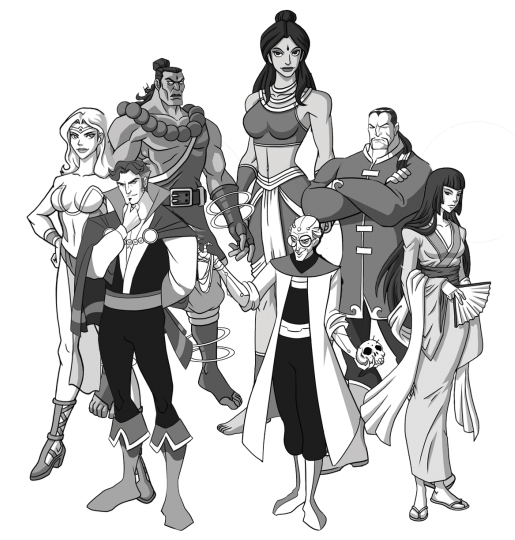
Meet the Gods! Top right is Liget , the one who is supposedly in charge of the bunch, he is always irritated at the other Gods because they're irresponsible or incompetent. The tall lady in the middle is Khali , she is the one who pays the most attention to humans, in the "I want to make you my pet" and the "has unleashed fire from the heavens more than any other God" sense of paying attention. Left of her is Yamaraj , a sadistic prick who demands perfection from his servants, it is said their screams can be often heard throughout the heavens although there are never any physical scars left. Zanami is the lady at the bottom right, who spends her days in quiet contemplation and chooses servants for their mental attributes and ability to meditate in between all the partying hard that the Gods love to do. The Wonder Woman fangirl is Pentheus who, well... I'll just quote the book here.
Mecha posted:
Pentheus is lust incarnate. The perfect vision of beauty and desire, Pentheus often earns the rest of the gods’ ire because she cares for nothing else other than pleasures of the flesh. While the rest of her fellow gods are not shy about obtaining pleasure, Pentheus does nothing else. She has turned both pleasure
and pain into an art form.
Will one day game designers learn that "This hot chick is all about sex" makes for a shitty enemy concept? Anyway, Mammon is the classy dude below her, who also gets his own eye-rolling description.
Mecha posted:
If Pentheus is the picture of female beauty, Mammon is the ideal man. He is a bronzed Latin god able to make women swoon even without his god status. He is quite taken with pleasures of the flesh and keeps a legion of beautiful women near him wherever he goes. But he might be the most intelligent of all the gods after Hinden. He is quite knowledge about business, economics, and the study of people. This makes him a formidable enemy
Last but not Least is the aforementioned Hinden, he is basically Dr. Mengele with a suit of powered armor, and is rumored to be behind most of the technology the Gods use. Also he is so creepy that he makes the other Gods nervous.
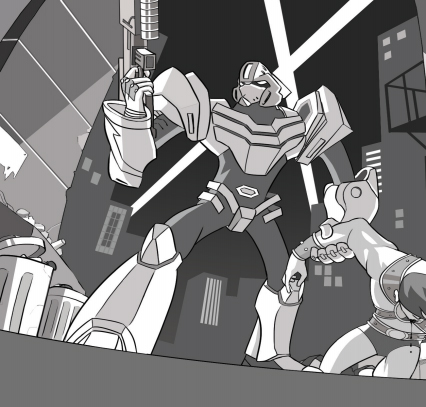
With the introductions over and done with. We can focus on how to play this thing. If you remember the Liberator Model presented several updates ago, it had a number of special rules. Some of these were related to the Cancer (or Free City) it sprouted from. It can not only talk telepathically with this Free City, but it also needs access to growths of Cancer in order to repair itself or to change Configurations, though each one has a limited number of damage points it can heal - specific number at the GM's discretion, no guidelines given at all.
Also of importance is their ability to be invisible to the Gods. See, the Gods can see and hear pretty much anything in the city, if you so much as mention anything remotely traitorous above a whisper then the
The Liberator can also talk to the Living City, though unlike the Free City (which will offer advice) the Living counterpart will keep telling them to give up and ask the Gods for forgiveness. The Free City can produce equipment such as weapons or mecha for the PCs much like the Living City can.
If you're a Godseed, you have a cool feature of your own: You can kill your parent God and inject yourself "some kind of shot" to gain their power. The PC goes comatose for twelve hours and awakens fully healed afterwards, and two feet taller than before for some reason. They may, with the GM's permission, gain access to their progenitor's stats, bioarmor, servants and all facilities.
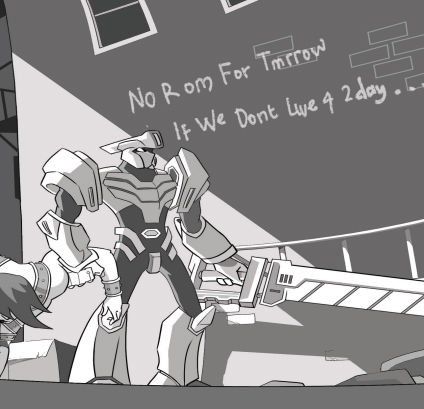
Story Stages
How does a Godblind campaign progress? There are Four Stages: First Contact, Unwanted Attention, Deity Revolution and Heaven is Burning. Each one has its own Initial Conditions, Types of Action, and Milestones.
During First Contact the PCs can act with near impunity until they get the revolution ball rolling, the scenes recommended are battles against minimally defended installations and Male or Female warriors without their Bio Armor. By the third or fourth attack the Gods should be getting their game on, however, and so we move on to...
... Unwanted Attention , beginning with the warriorization (actual word in the book) of all servants in heaven. The Gods send their armies to patrol the streets, whom randomly take out their zealous fury on the populace at large sometimes. During this Stage the PCs should ambush or be ambushed, and it is suggested they assassinate pageant and sporting event directors, because they serve the Gods by sending them servants. Other ideas include the existence of NPC Godblind, regular humans finding out a Godblind hideout (and potentially selling them out) and massacres of the citizenry at the order of the Gods.
Deity Revolution happens when even normal humans have been warriorized, they've already begun running athletic competitions and other pageants to build a reserve force too. Any attacks made during this period should involve an increasing number of Male and Female Warriors, as the PCs attempt to sabotage the recruitment process. When the pageant is over, one or more Gods will descend to pick the next batch of Warriors up - the PCs should take the opportunity to kill them.
Heaven is Burning has the Gods in a panic and the heavens depleted of humans, the various Godseed fight each other to see who gets the God injection, even those who are not bloodline related to the deceased deity. In the middle of this disarray the aggressive mindlessness of the Warriors spirals out of control. Recommended battles here are against other Godseed in their own Liberator class mecha, the berserking Warriors and the remaining Gods.
We are not given any of the answers as to what the hell is going on, which would be a nicer touch if we were given good examples or a cool sidebar with rumors. But this being Mecha, I fear it would only be about seducing the Living City to enact Evangelion's Instrumentality or something. All in all Godblind is a pretty cool idea, suffering from no one taking five minutes to proofread for the most part, the designs are okay and the action-packed feel of the campaign suits the gameplay style of Mecha pretty well, the rules of the game allowing a lucky dude to overpower a robot make sense in-setting too which is a nice touch.
Naturally, it only gets about 20 pages compared to the other two settings getting 40 in all their derivative glory.
Coming up Next: At least it isn't Mekton.
Ah yes, the so-called "Reapers"
Original SA post
Mecha: Ah yes, the so-called "Reapers"

Mecha posted:
Every kingdom divided against itself is brought to desolation; and every city or house divided against itself shall not stand.
-- Matthew 12:25
So begins Steel Gunner Destiny Tomorrow, the obligatory Gundam clone of the example settings. I think this SRS is the pet favorite of the designers, as it seems the most fleshed out and is the one used in the
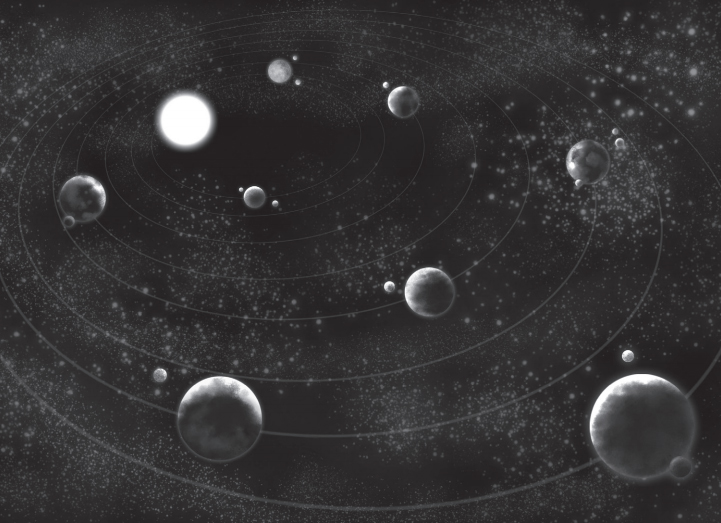
Set in the year 2237, in the remote Destiny Arbor system, humanity has long since colonized the stars and Destiny Arbor is but one of many places terraformed since then. The Mannis Dynasty has been a benevolent monarchy for the most part but that will soon change with the death of King Forrest Mannis, for his descendant Prince Arion plans to take away everything from the colonies in order to amass a grand army with which he will conquer the galaxy.
Five of the eight planets composing Destiny Arbor have banded together under the name of the Separatist Guard, with the goal of deposing the corrupt prince and establishing a democracy. The Prince's Arbor Defense Force has, of course, brandished them as traitors and insurgents standing in the way of his benevolent plans of peace and unity.
In order from Destiny (as in, the star) the planets in the system are: Gwandana, New Medina, Destiny Prime, Destiny II, Destiny III, Nevia, Abrax, and Elrand. The Destiny trinity are the ones aligned with the ADF, while the rest belong to the Separatists. As you can see the ADF is clearly sandwiched between the Separatists, or keeps them distanced from each other, depending on how you choose to view it.
The Arbor Defense Force
The ADF is your bog standard honorable spacenoid faction, they think they are on the right and that the Separatists are actual insurgents, because two hundred years in the future people still can't recognize a megalomaniacal tyrant when they see one. Anyway the ADF wants to unify Destiny Arbor, and look down on the guerrilla tactics use by the dishonorable Separatists.
Their center of power lies in Destiny Prime, an Earth-like World that was the first to be colonized. The planet is full of beautiful farmlands, advanced cities, climactic biomes, and other sorts of scifi-ish stuff that make it evident it could be self-sufficient. Also they apparently descend from English royalty, so all 'Destiny' planets have a culture and customs that resemble
Destiny II is some kind of planet-wide Archipelago. Not a single island is of size larger than Japan, but there's thousands of such continents, all very rich and fertile due to the constant volcanic activity. This planet is not only the granary of Destiny Arbor, but it also contains huge deposits of natural gas, oil and the rare mineral Izarium under its oceans. Izarium is, of course, our obligatory power source for the robots that handwaves their existence away.
Destiny III is a bizarre one, apparently it has a 'strange shape' that gives it extreme weather at both poles and along the equator. Not much more on this is elaborated, but we are told that the ADF has their training facilities here because going to another planet is like taking the bus right?
The Separatist Guard
The five baronies of the Separatist Guard all want their own democratic independence, and fancy themselves freedom fighters contrasting the sheeple under Prince Arion. The Separatists treasure Steel Gunners and their factories a lot more than the ADF does, because their resources are much more limited.
Abrax is a montanious planet with mountainside cities and oceanic trade routes, it is the industrial heart of the Separatist Guard and it produces 80% of the Separatist's Steel Gunners. Abraxians buy into the whole nobility and warrior's honor deal, they make some of the finest warriors and craftsmen in Destiny Arbor, all Abraxian nobles are given a priceless "Abraxian honor blade" as a family heirloom when they come of age. I was going to insert the 'Katana copypasta' in place of the rest of this entry and see if anyone noticed but it is already over! Next!
Elrand is the farthest world from the sun and it shows, the temperatures average at least ten degrees cooler than Destiny Prime (Whether it is Celsius or Fahrenheit, the book does not say) naturally they also have the finest beverages and vineyards in the system. Elrandians are stuck-up pricks and are convinced they are always right, they're very uptight about their own monarchy and its importance - moreso than the Destiny Prime-ians about theirs.
Gwandana is one of those gimmick 'desert planets', though they are taking the ice out of the corners of the world into space to hydrate the planet, which already makes this more thought out than most similar planets in fiction. Gwandana is far from being the Mannis' favorite, it only has had a name for the past seventy years even, until then it was just a bunch of stubborn settlers in a planet not officially inhabited by anyone from Destiny Arbor. The Gwandans are a proud people (like everyone else in Destiny Arbor, so far) tracing their culture and customs back to the ancient African tribes who were wiped out in the Corporate Wars in the mid-22nd Century. I have no goddamn idea where that came from, but it gets better! Much like the Abraxians they value martial prowess highly, but unlike them they are very spiritual and worship the nature spirits. For every five people in Gwandana, one is a shaman, and often they are commanders of Gwandanian units. Right, moving on...
New Medina is dubbed 'world of liquid', there's so much of it that most plant life was incompatible with the planet and it couldn't be terraformed outside of fish and sea vegetation. Not only do they ship all this water to Gwandana, but they are kings of oil trade. They may not have as much Izarium, but they have a large advantage over Destiny II where other resources are concerned. Cultiraly, it is a mishmash of European and Middle-eastern influences that only cooperate because they hate the ADF more than each other.
Nevia is a sea of green dotted with gray from space, this is because they went overboard with the terraforming business and in fifty years they already made a worldwide Amazon. Only three kinds of people ever come to Nevia: Lumberjacks who work for six months then rotate out, Christians who believe the planet is the Tree of Knowledge
 , and the Separatists because where else would you have your base of Operations but in Space Jaburo?
, and the Separatists because where else would you have your base of Operations but in Space Jaburo?
I said this before but I will restate: It is pretty cool that you don't actually have to play as a Separatist, you are free to choose whichever side your group will play as. Though I frankly have no idea how you could roleplay someone who doesn't notice how fishy Arion's deal is. The guy has been impoverishing entire planets and building a goddamn galaxy-conquering army, acts without which the baronies would have never opposed him in the first place, yet noooooone in the Destiny trinity thinks twice his mission statement of conquering everyone to have peace.
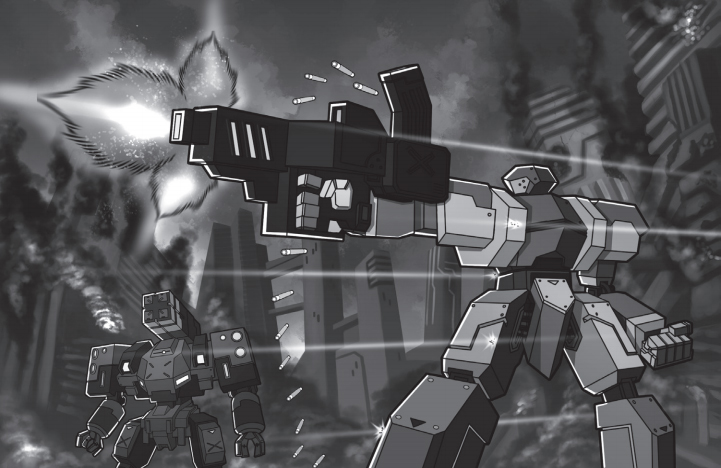
Tell me about the robots already.
Steel Gunners are 15 to 20 feet tall, originally used to mine asteroids and adapted as mobile weapons for the New Normandy Mining Wars. Conventional Infantry and other mechanized weapons are still largely useful, but Steel Gunners have a firm place in the battlefields of the future. The ADF often trains would-be pilots for a year in a specialized academy, the Separatists cannot afford such luxury, and in fact are generally outnumbered. The ADF takes every opportunity to market their numerous ace pilots as planetary heroes, there's plenty of merchandise to go from posters of real current media darlings to comic books of incredible war stories.
All Steel Gunners share the following basic features:
AEC (Anatomic Emulation Control) System - You have two foot pedals, two control sticks, and an array of switches and toggles to move your robot 'with an extremely natural freedom of movement and ability to perform precision tasks with great accuracy'. Science!
Life-Support System - There's a basic temperature control device in the cockpit, with 24 to 36 hours of oxygen supply and a small water reservoir.
Energy Coil - This is the big one. Remember that Izarium mineral? It can be refined into a self-sufficient power source. And naturally the first thing we are to do when we come upon unlimited energy is use it to make giant robots.
Sensors and Optics - The head of a Gunner usually packs a bunch of stuff like night and thermal vision, motion tracking and long-range zoom capabilities.
Orbital Boosters - Vital for 0G environs, though they are not powerful enough to allow atmospheric flight, they can be used to skim across the surface - this is called 'skating'.
Ejection System - This one apparently renders the Configuration supposed to let you eject safely useless, though no clear rules for its use are given.
Emergency Chute - For dropship usage.
Steel Gunners are usually deployed in squads of 4 or 5, often accompanied by either a Mobile Command Vehicle for long distance reconaissance and communications or the ship they're deploying from. Infantry, Tanks and other non-robots can oppose Gunners just fine - they're Mooks. In fact anything ranging from a combat motorcycle to a capitol ship is considered a mook, but no stats are given for any of the examples. Did these guys miss the memo that the person who wants ready-made characters is the GM, and that players generally don't want pregens? Because there's about a dozen and a half too many of the latter, and a dozen and half too few of the former. As for the models proper, I believe I reviewed the (extremely dull) models available briefly several updates ago along with their archetypes, I'll be taking a look at some of the (slightly less dull) stuff that isn't meant for PC use (at least not out of the box) this time.
But first, a few sample NPC Aces!
ADF
Nobis Everway - Callsign Noble. The Everways are the second richest family after the Mannis, and to show their support they've always been ones to give their children as pilots. Now they're watching if Arion is any competent at this whole space tyrant thing and watching the situation with the Separatists to see if he should be deposed.
The Raven - A woman of unknown name, but with an arrogance and bearing that could only stem from nobility. A clever commander with a tactical genius who keeps her subordinates in control out of fear they will be on the receiving end of her battle fury.
Dash Reinhold - Callsign Superstar. A media darling whose face has been recruiting more soldiers than every other star in the past ten years combined. He is kept away from the really tough battles so that his holofilms where he continuously saves the day can continue to be sold.
Donny Groceman - Callsign Crash. A hard working ace who started out as your everyday commoner, he was top of the class and earned himself a promotion to command-ry of an unit with similar origins. His competence is welcome, because they're all being sent to the dangerous assignments the nobleborns don't want to handle.
Separatist Guard
Paul Young - Callsign Hawk. A peaceful civvie who lost it all to an ADF attack, he is unsure of himself but has great potential.
Desiree Ramirez - Callsign Waxer. A nerd who sees quantum mechanics as infinitely less confusing than human interaction, and thus is "completely unaware of how her beauty affects her teammates".
Schnizel Demora - Callsign Prince. An ADF defector who wants to prove that he is better than his brothers, one of which still fights for Arion's crusade. Is extremely over his head.
Alex Wornall - Callsign Boiler. A bitter and alcoholic veteran that has been fighting for the Separatists since before they had that name.
If the last batch of dudes seem bland in comparison to the ADF's, that is because they get only one paragraph instead of the two the others get, it is pretty obvious the Separatists are rookies and allied grunts while the ADF aces are commanders who would make decent recurring enemies. In addition to this we get some useful non-combatants, mostly they're "Gunner Chiefs" or the officers that will be commanding the PCs from their MCVs.
Tembo Montreal - A Gwandanian shaman in-training, with an uncanny foresight and a deep connection to the spirit world.
Alessa Green - Beautiful and talented, she has been recently posted but makes up for lack of experience with empathy and... her ability to comfort pilots in the heat of battle. Also she has a mysterious past.
Alex Wendo - Alex aced the training program and a natural affinity for the intrincacies of Steel Gunners, he is recognized as a top of the line Gunner Chief in the ADF. He has a custom Gunner he services the most, called Sarah, after his dead fiancee. People think he is creepy.
Suki Yamura - One of the greatest Aces the Separatists ever had, whose career was promptly halted after a combat injury. Now she services robots and directs other aces-to-be. Suki has a no-nonsense attitude, a deep understanding of tactics, and the stubbornness to succeed where others fail.
Gordon Nemitz - The most experienced Chief in the ADF, serving for over forty years with exemplary marks. The man has lost all his family to Separatist insurgency, and genuinely believes that the ADF is in the right here.
Well at least the NPCs they do bother with are useful and - hold on, what is this last entry...?
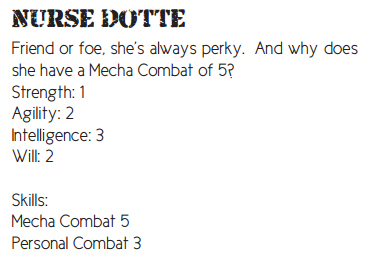
By this point in the book I was expecting to get stats for our supposed book guide, you know, Liutenant Mara Callahan of the 91st Separatist Forces? The one who was introduced at the very beginning? Well, she isn't. Probably because I haven't seen her anywhere since chargen and the writers forgot about her, curiously enough just when Dotte started to pop up all over the place in the many examples about how you can use every skill in the game to score. I bet scenes with Mara wouldn't be all about trying to seduce her, why did you replace Mara with Dotte you assholes?

Special Rules
Mark II Intuitive Gunners are the next generation of giant robots, the ADF has been experimenting for a while on how to improve reaction times and stuff by replacing all the levers and switches with a thought control interface directly. The joke is, not many are able to use this interface at all, because it requires you to be psychically sensitive enough to meld your mind with the AI installed. Or something. If you remember the Espers which I vaguely mentioned the last time we looked at this setting, this is them.
To create more Espers the ADF has also initiated Project Farsight. Recruits who score at least an 80 in the Josef-Sanz Psychic Awareness Battery are invited to a weekend resort, in which they are fed happy memories of sandy beaches and fun in the sun while the ADF experiments and reconditions them in order to reach the required score of 99 to interface with an Intuitive. Success rate is around 60%, with all dropouts obviously dying.
Project Farsight is available to any ADF pilots and to Separatists if they steal the technology. The Raven, of the premade NPCs, is said to turn into an Intuitive pilot after a while. Though I've already stated it the last time we looked at Steel Gunner, Espers (and their machines) are identic to non-Espers save for their Psychic Howl weapon.
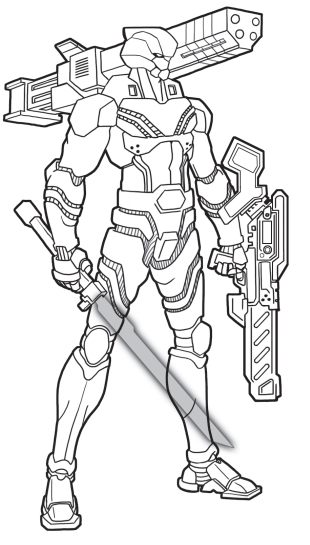
Depending on which side of the battle you are in, either ADF Scientists or Gwandanan Mystics will figure out the secret behind the Energy Coil's unlimited power:
Mecha posted:
The energy coil is basically a multi-dimension entanglement device that siphons energy from the realm of the dead. Quite by accident, it will become apparent that the energy coil’s field can actually capture the essence of dying pilots and trap it.
This means it is possible to achieve immortality if you are absorbed into the energy coil, with a few modifications you can be made to control any machines the coil is installed in. Energy coils modified to this use are renamed as Lazarus Coils. People who continue to live in this way are known as Revenants, and quickly become a creepy but necessary part of the ongoing war effort. Revenants keep their memories though after their death the people inside tend to be less talkative and enthusiastic about everything, for obvious reasons. Revenants give off strange radiation that garbles communications, videos of Revenant units always turn out grainy and filled with static, their voices always warble and so on.
But there is always a catch. For each successful Revenant, a rift opens to the realm of the dead, and from it will pour out the things that used to feed on those souls - Reapers. Reapers don't get a description but have all stats at 8, the Assassin and Ripper Configurations to murder people faster, and a suit of close to mid-range weapons. Naturally, they don't have skills to use said Weapons with because they didn't give them pilot stats

Revenants and Reapers are probably the coolest thing in the entire setting, single handedly saving it from being a shitty Jovian Chronicles or Heavy Gear knockoff. Not that they explore the ramifications of them beyond being able to turn dead people into Protoss Dragoons and fighting space Shinigami out of fucking nowhere, but at least they're there to serve as inspiration.

Story Stages
We have three Story Stages for both Separatist and ADF campaigns, which kinda sorta mirror each other.
In Contact the war has been going for two years, just enough to have a lot of bad blood all over but without everyone being exhausted. The ADF has the upper hand right now, since all planets have some kind of ADF base on them, the Separatists are short on aces and their gunners have seen better days. During this stage the PCs should do the regular stuff expected of them before the plot kicks in, which means patrolling, spending some downtime in the nearby town, assorted guerrilla operations and whatnot.
If the PCs are Separatists, this lasts until the ADF launches an assault of enough scale to down multiple NPCs, after somehow pulling through this battle somehow one or more of the Gunners are moving on their own - this leads to the discovery of Revenants and the Lazarus Coil. If they're ADF, then they also have to weather an overwhelming assault of their own, until they are saved by an Ace Intuitive Gunner. PCs can sign up for Project Farsight at this point, the Espers can also help discover Revenants.
In Tragedy we are told there should have been a timeskip, the war is now a stalled grind. The ADF has a slight advantage but the Separatists have their shit together by now, and the fielding of Revenants means they both have plenty of experienced pilots. Missions are largely the same, though with a Revenant twist, until we hit a Story Milestone in the ADF's assault of Abrax's capital of Casaleo.
Separatist forces all around Destiny Arbor are mobilized, hopefully they will arrive before all the enemies do. This is a good opportunity for the PCs to face their first Intuitive Gunners, but no matter how their own battles go, the city of Casaleo and all the forces stationed there are razed in an instant - turns out the attack itself was a diversion for the Destiny Siege, which is not explained anywhere in the book but I take is some kind of orbital superweapon. If you're playing as ADF, then your big battle is against the Reaper invasion that pours forth from the second use of Destiny Siege against Elrand - they hit the Intuitive Gunner corps the hardest. Once the Reapers are defeated, the rift closes.
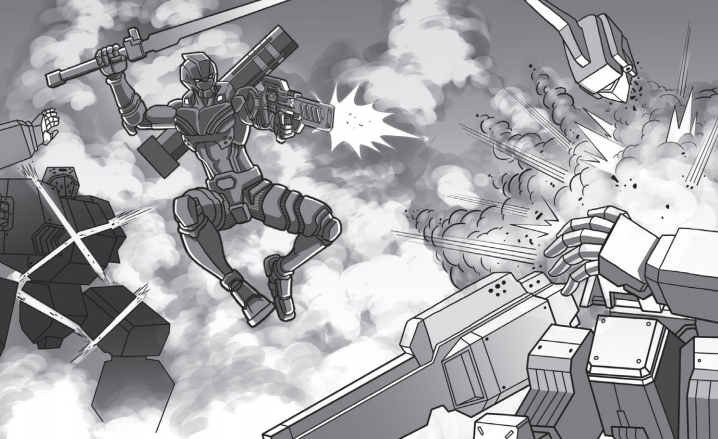
After the events of the last Story Stage, we immediately jump to Stage Three Destiny which actually changes timelinewise depending on whose side you're on. If you're a Separatist, the ADF has given the Separatists one week to surrender before they use it to destroy all of their capital cities. Meanwhile, Revenants act like they're in pain or afraid of something. If you're ADF, well, the Reapers are largely gone. Or you're all dead. One of the two.
Separatist missions here should be about finding the Destiny Siege, whether it is recon or kidnapping of ADF personnel, and hunting down the inevitable deserters that want to be on the side of the winners. Destiny Siege is found on the very last day before it fires on Elrand and who but the PCs are sent to blitz it down. Either way, the Reapers are scheduled to come into the stage after this, and they will decimate Destiny Prime, paving the way for victory.
The ADF side of it is about hunting down the remaining Reapers, sabotaging the preparations for the Separatist assault on Destiny Prime, and other last-standish stuff. Until the Separatist home base in Nevia is found, and the ADF sends their last remaining effective forces there, including the PCs.
Overall Steel Gunner Destiny Tomorrow is okay, there's a lot of potential in Revenants and Reapers which mostly goes to waste being unexplored, so it is largely your generic Mekton heartbreaker but with a system that you can play without wanting to poke your eyes out.
Coming up Next: Super Robot School
School Days in Glorious Californippon
Original SA post
Mecha: School Days in Glorious Californippon
Mecha posted:
Dear Most Fortunate Student,
This electronic communication has been happily sent to you by the administration of the Special Research School Combined System to inform you and your parents that you have been joyfully admitted to Special Research School West Campus! We proudly hope thatyou will be matriculating there this fall. Your parents have been thoughtfully copied on this electronic mail so that they may receive this benefi cial news and gladly remit their fi rst tuition payment due in ten days.
The Special Research Schools only accept the best and the brightest students who excel in the particular fi elds of study and athletics. Classes will be strenuous, but we have a number of special clubs in which you can participate to add fun diversions to your school day.
If you are planning on playing mecha football, gratefully find the attached weapons governor permission form. Fill it out in triplicate and quickly fax two copies to the Special Research School West Campus Athletics Director and one to the New Edo authorities.
Also, please studiously find a copy of all required materials you will need for your first day.
Dormitories open one week before classes start and all incoming freshmen are sternly required to arrive on the day the dormitories open for a week long orientation to the Special Research School Combined System. Come ready to learn and have fun. The first night, there will be a co-ed sock hop. Much Fun will be had!
Sincerely,
Administrator Hoshi Yoriburro
Special Research School Combined System
Fifteen minutes into the future, New Edo is the most technologically advanced country in the world. People have their own humanoid vehicles there, and they're common to the point that schools often play football matches against each other in those. This is the setting in which Special Research School takes place, more specifically SRS West, and as genre conventions demand the other schools will be our rivals.
After a brief introduction we open up with the fun stuff already, School Rules! . All students receive 'mecha learner' permits to use mecha within school limits if they have an authority figure with them, school uniform is to be worn at all times during the week and at formal events, leaving school grounds without a permit is strictly prohibited yadda yadda - Look, you know what a campus is like, don't you? Just add robots to the mix and let's get all these rules and regulations over with.
Campus has what you would expect it to have: There's dorms, classrooms, facility areas, an administrative building you're not supposed to go into beyond floor 1 under warning of disciplinary action, sports fields, and the much necessary mecha hangars which we are warned are always under watch. As for what you can do? There's a metric fuckton of clubs, for one.
Mecha posted:
Other than the Student Council, we have Kendo Club, Karate Club, Photography Club, Student Newspaper Club, Lacrosse Club, Art Club, Yearbook Club, Cheerleading, Fashion Club, Future Business Leaders of the World, Future Farmers of the World, Emo Club, Future Teachers of the World, Chemistry Club, Role Playing Club, Math Club, Science Club, Mecha Engineer Club, Pep Club, Glee Club, Dance Squad, Debate Club, Diving Club, Equestrian Club, Creative Writing Club, Auto Club, Computer Club, Movie Club, Poetry Club, Yoga Club, Environmental Club, Weightlifting Club, Cross Country, Track Club, Future Politicians Club, JROTC (Junior Reserve Officer Training Club), Home Ec Club, Audio/Visual Club, Solar Powered Mecha Team, and Band.
I like that there's a Future Business Leaders of the World Club, possibly right next to the Future Farmers of the World one. Also a Solar Powered Mecha Team. As far as other stuff goes, we have a list of yearly School Dances that we're supposed to be super excited about :
Mecha posted:
• Freshman Sock Hop
• Homecoming
• Winter Formal
• Spring “Girls Ask Guys” Mixer
• Junior Prom
• Senior Prom
• Graduation Dance
The most interesting thing to do here, beyond dicking around in the cafeteria is to enroll in mecha football. Even if you're a terrible nerd, one of the benefits of this game is that you can totally outjock the school bully with your piloting smarts. We'll get to the rules for that in a bit.
NPC And Location Laundry List
If you ever set out for a walk on the town, there's a few hot spots and groups to keep in mind, mostly the local gangs like the New Edo Dragons and the New Edo
SRS East - Next to the ocean, these guys love to brag about the views they get from campus. Also they love to brag about being state mecha football champs for seven years in a row, state debate champs for three, math olympics for ten, and having the best audio/visual club tech. Predictably, they're West's main rivals.
SRS North - This is the techie school, their graduates are the ones who take engineering prizes home or go for the Solar Powered Mecha races competitions. It is the largest of the schools, partly thanks to all the corporate funding behind it.
SRS South - The underdog new school with only three years since founding, it seems to be primarily an athlete's school and they've made some splash in that department despite being very new.
St. Thomas A'Mecha - A girls only Catholic School, and the most likely for recurring reappearances since it is only three kilometers away from SRS West. Students are chosen for their excellent academics and a lot of the girls there end up enrolling as Junior Corps Officers.
New Edo University High - Another techie school for dorks. Ninety percent of their students go on to become mecha engineers, usually with a specialization on designing new models. I have no idea why this wasn't rolled into North.
New Edo High - The largest public school in New Edo, they usually try to compete with the SRS but end up losing. Sounds like a pretty pointless entry.
Bronks Science - Located near SRS North, despite the name it attracts rougher folk than the nerdier schools, though they're often quite smart too. Bronks stuents have a reputation as mecha racers and many of their students uphold that reputation illegally on the weekends.
Modesto High - The obligatory awful school that sucks at everything. Located near East for extra hilarity.
Modesto High South - A branch of Modesto High that is near SRS South instead that is only slightly less terrible.
And then there's all the NPCs. How would you like 20 pages of nearly identical pregenned guys? Not at all? Well me neither, so I'm going to stick to the named characters and stop myself from falling asleep at the computer.
Principal Sanagaki - The rarely seen Principal Sanagaki is rumored to hate his job and to wish he'd been assigned to SRS South instead, so he usually leaves the job to the Vice Principal. The guy loves football, and apparently only shows up during the school dances.
Vice Principal Belden - Sent from America in order to learn all about SPECIAL RESEARCH SCHOOLS from glorious nippon itself, he's thrice divorced and it doesn't take much to figure out why. Also, this.
Mecha posted:
Weapons Systems
Vice Principals Rage (0/Wave)
Confscated Slingshot (1/Impact)
Student Seeking Missiles (3/Missile)
Anti-Truant Beam (4/Energy)
Coach Grunhard - A retired mecha football pro. Dude's loaded and gruff, yet surprisingly nice when he's not yelling at you for slacking.
Nurse Dotte -
Mecha posted:
Nurse Dotte is the lovable school nurse that raises heart rates around the schools. She’s loveable and surprisingly competent around her job despite her incessant perkiness.
 and she
still
has no points in Medicine.
and she
still
has no points in Medicine.
Janitor Boro - A guy with a mysterious past and a Tongue Depressor copypasted from Dotte for a weapon, he's not much of a people person but is somehow a great source of gossip if you get him to warm up to you. He also has the Assassin Configuration, 5 Strength and 5 Weapons so he's probably some kind of downplayed badass mentor archetype.
Chef Akebono - Akebono is a cheerful fat chef stereotype that likes to give people extra servings of stuff they didn't ask for. As for the quality of his food... He used to work at the nearby Kelly's, and business there picked up dramatically after he left.
Mr. Head, the Science Teacher - Mr. Tondu earned the nickname of Mr. Head because of his crazy hair. Guy loves science and experiments, even if they blow up on his face or cover the entire class in unknowable substances.
Ms. Pennypeacher, the Home Ec Teacher - A british lady of stature who continuously tries to instill 'British propierty' on the class. She also designs the very uninspiring but very proper cheerleading routines.
Mrs. Tondu, the Match Teacher - The wife of Mr. Head is not very cool with robots and will lead a campaign against them. More on that later. One of her weapons is burying you under homework.
SRS East Principal Biller - A lanky and perpetually sneering ex-soldier who looks like he hasn't slept in ten years. Rather unlikable.
Student Council President Victory Watanabe - A perfectionist who is as tyrannical as she is utilitarian, cross her and your club budget will all but vanish and all sorts of ugly rumors will pop up about you. Gain her favor... and you will have to pay her back tenfold eventually.
Head Cheerleader Kallen Saito - Probably the prettiest girl in the school, also universally mean to everyone, but mostly the rest of the cheerleader team.
Upperclassman Jock Roman Hondo - Star player Roman is the stereotypical awesome player who is also an arrogant ass that mistreats his girlfriend Raquel. We don't know anything else about her, though. Nor about him.
School Newspaper Reporter Trisha Kozaki - A snoopy one who can't keep a secret. Next!
Cindy, the Waitress - She works at the Hyper Drive-In, a mecha drive-by, and she serves people roller skating over to them with their food. The future is truly an awesome place.
Kelly of Kelly's Restaurant - Next to the Hyper Drive-In, Kelly's is a super busy place. Kelly herself is an ex-SRS West student and usually helps out kids escaping from Vice Principal NoFunAllowed... except that now she does it less, and rumor is that she's now involved with him. Also she keeps an energy shotgun behind the counter 'just in case'... Yeah, sure, okay.
Mr. Yakitori of Yakitori's Restaurant - An old cook who seems to be going blind but refuses to hire anyone to help him out. He's all too eager to give misbehaving kids a piece of his mind.
The Phantom - A mysterious racer with a yellow robot. Probably someone's missing brother. Is rumored to be looking for a successor to his legacy.
Sheriff Gendo Torinaga - A former marine, he really doesn't like crime and is currently trying to stop illegal races. This has made him a few enemies on the student body.
Howling Dragon Jack - A super popular local radio disc jockey who gives love advice on air, every diner seems to have him on when it airs - every night from eight to midnight.
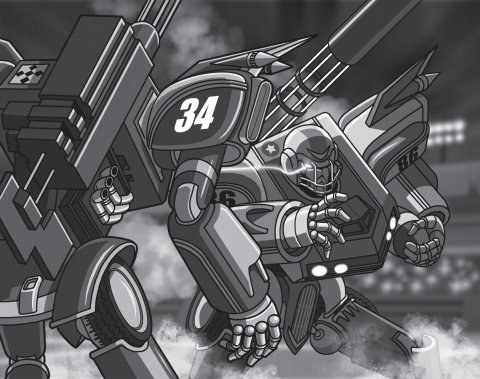
Mecha football! It is super popular in high school and every country has a national team these days. The rules are rather similar to those of standard combat.
-There's two Goals at two opposing outermost Quadrants, instead of a Tactical Waypoint there's a ball that Mecha in the same sector can pick up by spending a Movement Point during their Turn. Players can spend Tactical Points to alter their starting positions or the ball's at this point.
-Mecha with the ball may make an Attack roll with the intent of passing it to another Mecha using successes as Movement Points. If a Mecha begins their Turn at the other side's endzone with the ball, they score a goal.
-Every time a Mecha is damaged, it loses its next half action. Multiple attacks stack. More importantly, damaging someone who has the ball makes them lose it, and it scatters 1d3 movement points in a direction of the attacker's choosing.
-Sanctioned encounters also use special weaponry that cannot make other Mecha enter the lethal damage phase. The street version has no such limitations and it is not uncommon for people to come back with lasting injuries or even dead from said matches.
-After a goal all positions are reset, Players may spend more Tactical Points, etc. The side that just got served moves first like in a surprise round, but with all their enemies still getting a chance to move - just after them. Matches are usually to the best of three.
Story Stages
Story stages in Special Research School are for the PC's Freshman, Sophomore, Junior and Senior years. They're even more like guidelines than those for Godblind and Steel Gunner, since this SRS is mostly open ended and player driven without a real unifying plotline.
Freshman Year is recommended to begin by establishing that the PCs are the bottom of the food chain. They should get a feel for the place trying out clubs, teams, and whatnot. But the GM should make them as miserable as real freshmen are, great idea! They shouldn't get dates or be wanted on the football team, nerds should be shoved into lockers, and club leaders shouldn't let them get away with anything cool. The PCs should get a chance to counteract their tyrannical overlords throughout the year, as there are a number of important events in which they can play their agenda or sabotage theirs.
At the beginning of Sophomore Year PCs get a break as there are more interesting targets for abuse than themselves. To shake things up while people continue their plots from the year past a number of events take place: First, some asshole named Nick Nova was scouted by the school authorities to win them a state championship, this guy is supposed to be a star player despite being a Freshman and will alter the balance of power for obvious reasons - even SRS East will try to vandalize West, giving credence to rumors they wanted this guy for themselves. The second event should be the death of Senior Alex Yun during an illegal race with the folk from Bronks, this kickstarts the National Organization of Ethics, Culture and Honesty Association (N.O.M.E.C.H.A) to protest against mecha racing, football, or anything with robots at all. The third event is the arrival of a group of girls from St. Thomas A'Mecha to the Winter Formal and them trying to ask guys from West to the Spring Mixer, including Nick Nova. There is no real plot to this as far as I can see, it just seems to be a random encounter. Lastly, the Dragons and the Snakes/Sharks get popular with the last batch of freshmen whom in turn try to recruit more students for their ranks.
Junior Year is the worst for West so far, Nick Nova transfers to East and without key PC activity to interfere the West Turtles will suffer a traumatic landslide defeat to his East Missiles. Who the fuck calls a sports team Turtles, anyway? NOMECHA is going to continue and try recruiting PCs or convincing them that they're on the right, while the gangs will likely pick a fight with anyone who picks the wrong side or doesn't pick one. Speaking of improper behavior, many authorities are likely to turn a blind eye to anyone who vandalizes East this year in return for their colossal dickery. Beyond that, Junior PCs now have a fair chance of winning Student Council Elections or getting to direct their own clubs.
It all comes to a close on Senior Year , when the PCs get all the power they ever wanted. Principal Sanagaki lost his job after being way too cool with all the vandalizing of East, and Belden will not be nearly as forgiving - he will personally go out with his Mecha to stop anyone who sneaks out using theirs . Meanwhile, NOMECHA folks are getting more violent, and PCs will likely have to trade blows with them at some point. This game just got a ton more interesting. There's no suggested climax to this arc other than college entrance exams at the end of the year, so personal stories should come to the front, as their responsibilities in this time of chaos make things harder for them.
And that's Special Research School. Having played games like it, slice of life with robots isn't as boring as it sounds... its just that this one is specially devoid of anything remotely resembling an overarching plotline. The closest thing we get is Belden's rise to power and the inevitable showdown with the PCs which is the most awesome thing in this entire SRS. Mecha Football seems well thought-out and it sounds more balanced than traditional combat, so there's that.
Coming up Next: A word from the author and closing thoughts.
Drawing the Curtains
Original SA post
Mecha: Drawing the Curtains.
The last two pages of the book are the author's own thoughts on the game, which are kind of surprising. Designing this game was a substractive process: The original version was very realistic and far crunchier, but the bug of streamlining and focusing on genre conventions bit him and so he started to fix things up. That is why there's only six skills and why there's no real equipment rules, since characters are often amazing pilots even if they've never read the manual, and never have to worry about having money or items.
Ultimately Mecha (the game) is a toolbox, not entirely unlike GURPS, that can help you stage games that are noir, gritty, fantastic, and whatever else you can think of - just like mecha anime, really. Chief inspiration for this book were Super Dimension Fortress: Macross (Robotech), Southern Cross, Code Geass, 08th MS Team, Macross Plus, Gundam Wing, Big O, Neon Genesis Evangelion, Project A-ko, and to a lesser extent VOTOMS and Full Metal Panic. What I find really weird is that while I can see myself using this to run the latter two, I certainly wouldn't do it for all the other ones. For various reasons.
Here comes the criticism: Mecha's rules are lacking in depth and not very well explained at best, but bland and repetitive at worst. It isn't very well balanced (most configurations are kinda sorta useful, some are incredible, and a few of them explode from terrible to ridiculous if you can keep spamming them) and a good chunk of them are outright stupid (Anything related to Traits, XP, or Archetypes) but it is all for a purpose. It has style and is fast . It may not give a fuck about balance but by God what it gets right it gets right . Linked stats are brilliant, the premade Model/Archetype mode of character creation lets you pick the game up and be playing a game in minutes, and in good storygame fashion you can get multiple 'episodes' complete with combat done in a single night of play.
That said, I would have liked it better if they actually put effort into proofreading this thing. I've brought up some of the more troublesome errors but I've spared you the majority of them. I've also been correcting some of the more obvious typos and omissions as I explained them, but there's quite a few rules that make no goddamn sense or contradict the rest of the book. Also fuck Nurse Dotte and whoever thought every single example of everything in the game had to either be completely obvious or about seduction instead of giving actually helpful advice.
This game really works if you want to run an action packed campaign that doesn't waste time not making things happen. Even downtime powers people up by giving them Overdrive points! A lucky/crazy powerful pilot (or a number of them) can take out a robot with some effort, which works really well for representing the grittier stuff out there and the built-in alternate victory condition in the tactical waypoint adds some variety to traditional 'kill em all' style combat. Ultimately while it has its fair share of problems it is easier to fix than the majority of its competition and takes less effort to prep and run than say D&D 3.5. Their forums were full of houserules last time checked, so that's nice too.
Coming up Next: Did you know John Wick made a Mecha game? Well neither did the rest of the Internet! Buckle up, this is going to be a fun ride...